Fujifilm FINEPIX S5200, FINEPIX S5600 Manual
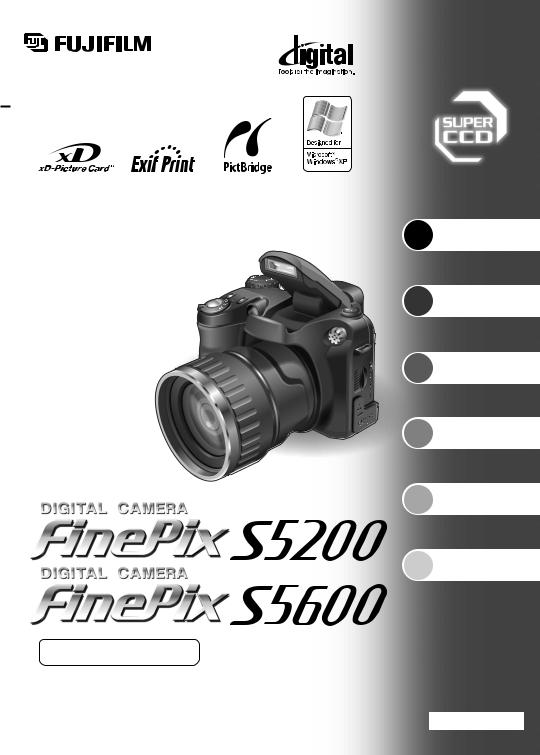
1
2
3
4
5
6
Getting Ready
Using
the Camera
Advanced
Features
Settings
Software
Installation
Viewing Images
OWNER’S MANUAL
This manual will show you how to use your
FUJIFILM DIGITAL CAMERA FinePix S5200 / FinePix S5600 correctly. Please follow the instructions carefully.
BL00484-200(1) 
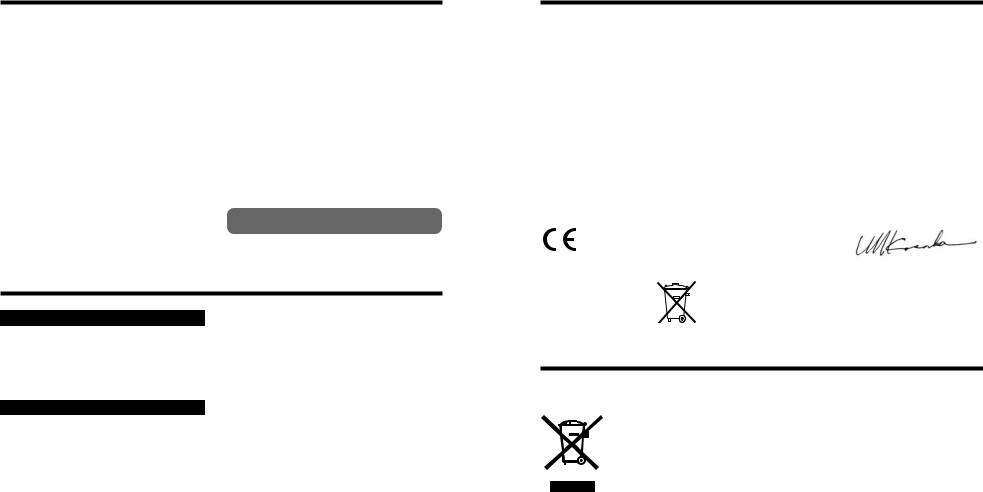
Warning
To prevent fire or shock hazard, do not expose the unit to rain or moisture.
For customers in the U.S.A.
Tested To Comply
With FCC Standards
FOR HOME OR OFFICE USE
FCC Statement
This device complies with part 15 of the FCC Rules. Operation is subject to the following two conditions: (1) This device may not cause harmful interference, and (2) this device must accept any interference received, including interference that may cause undesired operation.
CAUTION
This equipment has been tested and found to comply with the limits for a Class B digital device, pursuant to Part 15 of the FCC Rules. These limits are designed to provide reasonable protection against harmful interference in a residential installation. This equipment generates, uses, and can radiate radio frequency energy and, if not installed and used in accordance with the instructions, may cause harmful interference to radio communications. However, there is no guarantee that interference will not occur in a particular installation. If this equipment does cause harmful interference to radio or television reception, which can be determined by turning the equipment off and on, the user is encouraged to try
IMPORTANT
to correct the interference by one or more of the following measures:
—Reorient or relocate the receiving antenna.
—Increase the separation between the equipment and receiver.
—Connect the equipment into an outlet on a circuit different from that to which the receiver is connected.
—Consult the dealer or an experienced radio/TV technician for help.
You are cautioned that any changes or modifications not expressly approved in this manual could void the user’s authority to operate the equipment.
Notes on the Grant:
To comply with Part 15 of the FCC rules, this product must be used with a Fujifilm-specified ferrite-core A/V cable, USB cable and DC supply cord.
For customers in Canada
CAUTION
This Class B digital apparatus complies with Canadian ICES-003.
Please read the Safety Notes ( P.135) and make sure you understand them before using the camera.
Be sure to read this page before using the Software.
NOTICE
BEFORE OPENING THE CD-ROM PROVIDED BY FUJI PHOTO FILM CO., LTD., PLEASE READ THIS END USER LICENSE AGREEMENT CAREFULLY. ONLY IF YOU AGREE WITH THIS AGREEMENT, SHOULD YOU USE THE SOFTWARE RECORDED ON THE CD-ROM. BY OPENING THE PACKAGE, YOU ACCEPT AND AGREE TO BE BOUND BY THIS AGREEMENT.
End User License Agreement
This End User License Agreement (“Agreement”) is an agreement between Fuji Photo Film Co., Ltd. (“FUJIFILM”) and you, which sets forth the terms and conditions of the license granted for you to use the software provided by FUJIFILM.
The CD-ROM contains third party software. In case a separate agreement is provided by a third party supplier for its software, the provisions of such separate agreement shall apply to the use of such third party software, prevailing over those of this Agreement.
1.Definitions.
(a)“Media” means the CD-ROM titled “Software for FinePix CX” which is provided to you together with this Agreement.
(b)“Software” means the software which is recorded on Media.
(c)“Documentation” means the operation manuals of Software and other related written materials which are provided to you together with Media.
(d)“Product” means Media (including Software) and Documentation collectively.
2.Use of Software.
FUJIFILM grants to you a nontransferable, nonexclusive license:
(a)to install one copy of Software onto one computer in binary machine executable form;
(b)to use Software on the computer onto which Software is installed; and
(c)to make one backup copy of Software.
3.Restrictions.
3.1 You shall not distribute, rent, lease or otherwise transfer all or any part of Software, Media or Documentation to any third party without FUJIFILM’s prior written consent. You also shall not sublicense, assign or otherwise transfer all or any part of the rights granted to you by FUJIFILM under this Agreement without FUJIFILM’s prior written consent.
3.2 Except as expressly granted by FUJIFILM hereunder, you shall not copy or reproduce all or any part of Software or Documentation.
3.3 You shall not modify, adapt or translate Software or Documentation. You also shall not alter or remove copyright and other proprietary
notices that appear on or in Software or Documentation.
2 3.4 You shall not, or shall not have any third party, reverse-engineer, decompile, or disassemble Software.
4.Ownership.
All copyrights and other proprietary rights to Software and Documentation are owned and retained by FUJIFILM or the third party suppliers as indicated on or in Software or Documentation. Nothing contained herein shall be construed, expressly or implicitly, as transferring or granting any right, license, or title to you other than those explicitly granted under this Agreement.
5.Limited Warranty.
FUJIFILM warrants to you that Media is free from any defect in material and workmanship under normal use for ninety (90) days from the date of your receipt of Media. Should Media not meet the foregoing warranty, FUJIFILM shall replace such defective Media with other Media bearing no defect. FUJIFILM’s entire liability and your sole and exclusive remedy with regard to any defect in Media shall be expressly limited to such FUJIFILM’s replacement of Media as provided herein
6.DISCLAIMER OF WARRANTY.
EXCEPT AS PROVIDED IN SECTION 5 HEREIN, FUJIFILM PROVIDES PRODUCT “AS IS” AND WITHOUT WARRANTIES OF ANY KIND, EXPRESS OR IMPLIED. FUJIFILM SHALL MAKE NO WARRANTY, EXPRESS, IMPLIED OR STATUTORY, AS TO ANY OTHER MATTERS, INCLUDING, BUT NOT LIMITED TO NONINFRINGEMENT OF ANY COPYRIGHT, PATENT, TRADE SECRET, OR ANY OTHER PROPRIETARY RIGHTS OF ANY THIRD PARTY, MARCHANTABILITY, OR FITNESS FOR ANY PARTICULAR PURPOSE.
7.LIMITATION OF LIABILITY.
IN NO EVENT SHALL FUJIFILM HAVE ANY LIABILITY FOR ANY GENERAL, SPECIAL, DIRECT, INDIRECT, CONSEQUENTIAL, INCIDENTAL, OR OTHER DAMAGES (INCLUDING DAMAGES FOR LOSS OF PROFITS OR LOST SAVINGS) INCURRED FROM THE USE OF OR INABILITY TO USE PRODUCT EVEN IF FUJIFILM HAS BEEN ADVISED OF THE POSSIBILITY OF SUCH DAMAGES.
8.No export.
You acknowledge that neither Software nor any part thereof, will be transferred, or exported to any country or used in any manner in violation of any export control laws and regulations to which Software is subject.
9.Termination.
In case you breach any of the terms and conditions hereof, FUJIFILM may immediately terminate this Agreement without any notice.
10.Term.
This Agreement is effective until the date when you cease to use Software, unless earlier terminated in accordance with Section 9 hereof.
11.Obligation upon termination.
Upon termination or expiration of this Agreement, you shall, at your own responsibility and expense, delete or destroy immediately all Software (including its copies), Media and Documentation.
12.Governing Law.
This Agreement shall be governed by and construed in accordance with laws of Japan.
EC Declaration of Conformity
We |
Fuji Photo Film (Europe) G.m.b.H. |
Name: |
|
Address: |
Heesenstrasse 31 |
|
40549 Dusseldorf, Germany |
declare that the product |
|
Product Name: |
FUJIFILM DIGITAL CAMERA FinePix S5200 / FinePix S5600 |
Manufacture’s Name: |
Fuji Photo Film Co., Ltd. |
Manufacture’s Address: 26-30, Nishiazabu 2-chome, Minato-ku,
Tokyo 106-8620, Japan
is in conformity with the following Standards Safety: EN60065
EMC: EN55022: 1998 Classe B
EN55024: 1998
EN61000-3-2: 1995 + A1: 1998 + A2: 1998
following the provision of the EMC Directive (89/336/EEC, 92/31/EEC and 93/68/EEC) and Low Voltage Directive (73/23/EEC).
Dusseldorf, Germany |
August 1, 2005 |
|
Place |
Date |
Signature/Managing Director |
Bij dit produkt zijn batterijen geleverd. Wanneer deze leeg zijn, moet u ze niet weggooien maar inleveren als KCA
Disposal of Electric and Electronic Equipment in Private Households
Disposal of used Electrical & Electronic Equipment (Applicable in the European Union and other European countries with separate collection systems)
This symbol on the product, or in the manual and in the warranty, and/or on its packaging indicates that this product shall not be treated as household waste.
Instead it should be taken to an applicable collection point for the recycling of electrical and electronic equipment.
By ensuring this product is disposed of correctly, you will help prevent potential negative consequences to the environment and human health, which could otherwise be caused by inappropriate waste handling of this product.
If your equipment contains easy removable batteries or accumulators please dispose these separately according to your local requirements.
The recycling of materials will help to conserve natural resources. For more detailed information about recycling of this product, please contact your local city office, your household waste disposal service or the shop where you have purchased the product.
In Countries outside the EU:
If you wish to discard this product, please contact your local authorities and ask for the correct way of disposal.
3

Contents
Warning .............................................................................. 2
IMPORTANT ...................................................................... 2
EC Declaration of Conformity ............................................. 3
Disposal of Electric and Electronic Equipment in Private Households 3
Preface ............................................................................... 6
1 Getting Ready
Accessories included .......................................................... 7 Camera parts and features ................................................. 8
Example of screen text display ...................................... 9 ■ Photography mode ............................................... 9
■ Playback mode ..................................................... 9
2 Using the Camera
|
|
|
|
|
|
|
|
|
|
|
|
TAKING PICTURES (AUTO MODE) ...................................................................................................................................... 21 |
|||||||||
|
|
|
USING LCD MONITOR .................................................................................................................................................... 24 |
|||||||
|
|
|
INDICATOR LAMP DISPLAY .......................................................................................................................................... 24 |
|||||||
|
|
|
AF-ASSIST ILLUMINATOR ............................................................................................................................................. 25 |
|||||||
|
|
|
NUMBER OF AVAILABLE FRAMES ............................................................................................................................... 25 |
|||||||
|
|
|
|
■ Standard number of frames per xD-Picture Card ..................................................................................................... 25 |
||||||
|
|
|
USING AF/AE LOCK ........................................................................................................................................................ 26 |
|||||||
|
|
|
SHOOTING ASSISTANT FUNCTION |
............................................................................................................................. 27 |
||||||
|
PLAYBACK MODE |
|
|
|
|
|
.............................................................................................................................. 28 |
|||
|
VIEWING THE IMAGES (w PLAYBACK) |
|||||||||
|
|
|
Single-frame playback / Selecting images / Multi-frame playback ................................................................................... 28 |
|||||||
|
|
|
Sorting by date ................................................................................................................................................................. 29 |
|||||||
|
|
|
Playback zoom ................................................................................................................................................................. 31 |
|||||||
|
ERASING IMAGE (ERASE FRAME) ...................................................................................................................................... 32 |
|||||||||
|
3 Advanced Features |
|
||||||||
|
|
|
||||||||
|
|
|
|
|
|
|
|
|
|
|
|
FOCUSING (DISTANCE) ........................................................................................................................................................ 34 |
|||||||||
|
EXPOSURE (SHUTTER SPEED AND APERTURE) ............................................................................................................. 35 |
|||||||||
|
TAKING PICTURES — SELECTING THE CAMERA SETTINGS .......................................................................................... 36 |
|||||||||
|
SELECTING PHOTOGRAPHY MODE ................................................................................................................................... 38 |
|||||||||
|
B AUTO ............................................................................................................................................................................ 38 |
|||||||||
|
SCENE POSITION .................................................................................................................................................................. 38 |
|||||||||
|
|
N |
|
................................................................................................................................................PROGRAMMED AUTO |
39 |
|||||
|
|
|
|
|||||||
|
|
M |
|
.......................................................................................................................................SHUTTER-PRIORITY AUTO |
40 |
|||||
|
|
|
|
APERTURE-PRIORITY AUTO |
41 |
|||||
|
|
< |
|
|||||||
|
|
|
|
|||||||
|
|
> |
|
.......................................................................................................................................................................MANUAL |
|
|
|
42 |
||
|
|
D |
EXPOSURE COMPENSATION ....................................................................................................................................... 43 |
|||||||
|
CONTINUOUS AF |
.................................................................................................................................................................. 44 |
||||||||
|
MANUAL FOCUS |
.................................................................................................................................................................... 45 |
||||||||
|
|
e MACRO (CLOSE-UP) ...................................................................................................................................................... 46 |
||||||||
|
|
d FLASH PHOTOGRAPHY ................................................................................................................................................. 47 |
||||||||
|
|
f CONTINUOUS SHOOTING ............................................................................................................................................. 50 |
||||||||
|
|
fi INCREASING MONITOR BRIGHTNESS ........................................................................................................................ 53 |
||||||||
|
pPHOTO MODE PHOTOGRAPHY |
|
|
|||||||
|
˘ QUALITY MODE (NUMBER OF RECORDED PIXELS) .................................................................................................. 54 |
|||||||||
|
|
|
Quality settings in Photography mode |
............................................................................................................................. 55 |
||||||
|
û SENSITIVITY |
................................................................................................................................................................... 56 |
||||||||
|
ü FinePix COLOR ............................................................................................................................................................... 57 |
|||||||||
|
PHOTOGRAPHY MENU |
|
|
|
|
|
||||
|
SETTING PHOTOGRAPHY MENU ........................................................................................................................................ 58 |
|||||||||
|
|
|
Changing the page number .............................................................................................................................................. 59 |
|||||||
|
PHOTOGRAPHY MENU ......................................................................................................................................................... 60 |
|||||||||
|
|
Ä SELF-TIMER PHOTOGRAPHY ....................................................................................................................................... 60 |
||||||||
|
ˆ PHOTOMETRY ................................................................................................................................................................ 61 |
|||||||||
|
» WHITE BALANCE (SELECTING THE LIGHT SOURCE) ................................................................................................ 61 |
|||||||||
|
â HIGH-SPEED SHOOTING ............................................................................................................................................... 63 |
|||||||||
|
|
H AF MODE ......................................................................................................................................................................... 63 |
||||||||
4 |
|
G SHARPNESS |
................................................................................................................................................................... 65 |
|||||||
|
Á BRACKETING .................................................................................................................................................................. 65 |
|||||||||
|
|
|
|
|
|
|
|
|
|
|
B PLAYBACK
PLAYBACK FUNCTIONS
PLAYBACK INFORMATION ................................................................................................................................................... 66
PLAYBACK MENU
Ò ERASING SINGLE / ALL FRAMES ................................................................................................................................. 67 Ú IMAGE ROTATE .............................................................................................................................................................. 69
pPHOTO MODE PLAYBACK
¸ HOW TO SPECIFY PRINT OPTIONS (DPOF) ................................................................................................................ 70 ¸ SPECIFYING DPOF SETTINGS EASILY ........................................................................................................................ 71
PLAYBACK MENU
¸ DPOF SET FRAME .......................................................................................................................................................... 73 ¸ DPOF ALL RESET ........................................................................................................................................................... 75 Ç PROTECTING IMAGES: FRAME / SET ALL / RESET ALL ............................................................................................ 76 ◊ AUTOMATIC PLAYBACK ................................................................................................................................................ 78 Â RECORDING VOICE MEMOS ........................................................................................................................................ 79 Â PLAYING BACK VOICE MEMOS .................................................................................................................................... 81
■ Playing back voice memos ........................................................................................................................................... 81 Adjusting volume of voice memos .................................................................................................................................... 82 ¯ TRIMMING ....................................................................................................................................................................... 83
B MOVIE
MOVIE MODE
r RECORDING MOVIES .................................................................................................................................................... 85 ■ Recording times per xD-Picture Card ......................................................................................................................... 86
pPHOTO MODE MOVIE
˘ QUALITY SETTINGS IN MOVIE MODE .......................................................................................................................... 87
PLAYBACK MODE
PLAYING BACK MOVIES ....................................................................................................................................................... 88 ■ Playing back movies ..................................................................................................................................................... 88 Adjusting volume of movies ............................................................................................................................................. 89
4 Settings
5 Software Installation
6 Viewing Images
System Expansion Options ........................................... |
115 |
AC Power Adapter .................................................... 119 |
Accessories Guide ........................................................ |
116 |
Discharging rechargeable batteries .......................... 120 |
Overview of the conversion lens ................................... |
117 |
Notes on the xD-Picture Card™ .................................. 122 |
Wide Conversion Lens WL-FX9B ............................. |
117 |
Warning Displays .......................................................... 123 |
Using Your Camera Correctly ....................................... |
118 |
Troubleshooting ............................................................. 125 |
Power Supply and Batteries .......................................... |
118 |
Specifications ................................................................ 127 |
Applicable Batteries .................................................. |
118 |
Explanation of Terms .................................................... 130 |
Notes on the Batteries .............................................. |
118 |
FUJIFILM Digital Camera Worldwide Network .............. 131 |
Using the AA-size Ni-MH batteries correctly ............. |
119 |
Safety Notes .................................................................. 135 |
1
2
3
4
5
6
5
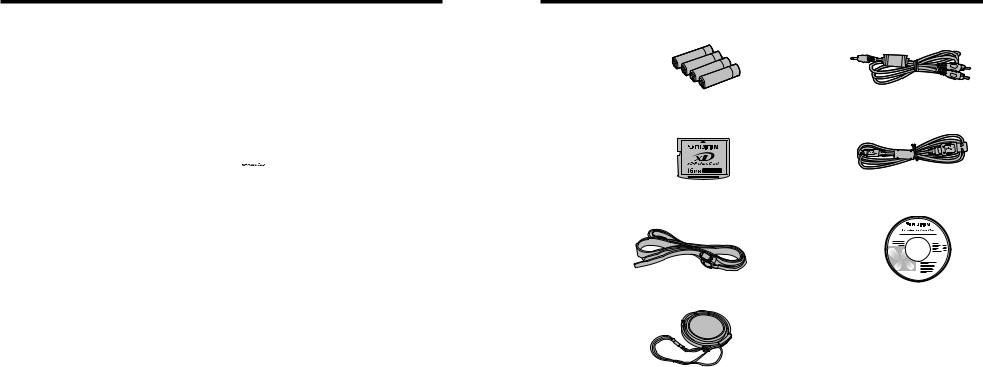
Preface
■ Test Shots Prior to Photography
For important photographs (such as weddings and overseas trips), always take a test shot and view the image to make sure that the camera is working normally.
h Fuji Photo Film Co., Ltd. cannot accept liability for any incidental losses (such as the costs of photography or the loss of income from photography) incurred as a result of faults with this product.
■ Notes on Copyright
Images recorded using your digital camera system cannot be used in ways that infringe copyright laws without the consent of the owner, unless intended only for personal use. Note that some restrictions apply to the photographing of stage performances, entertainments and exhibits, even when intended purely for personal use. Users are also asked to note that the transfer of xD-Picture Card containing images or data protected under copyright laws is only permissible within the restrictions imposed by those copyright laws.
■ Liquid Crystal
If the LCD monitor is damaged, take particular care with the liquid crystal in the monitor. If any of the following situations arise, take the urgent action indicated.
h If liquid crystal comes in contact with your skin
Wipe the area with a cloth and then wash thoroughly with soap and running water.
h If liquid crystal gets into your eye
Flush the affected eye with clean water for at least 15 minutes and then seek medical assistance.
h If liquid crystal is swallowed
Flush your mouth thoroughly with water. Drink large quantities of water and induce vomiting. Then seek medical assistance.
■ Notes on Electrical Interference
If the camera is to be used in hospitals or aircrafts, please note that this camera may cause interference to other equipment in the hospital or aircraft. For details, please check with the applicable regulations.
■ Handling Your Digital Camera
This camera contains precision electronic components. To ensure that images are recorded correctly, do not subject the camera to impact or shock while an image is being recorded.
■ Trademark Information
h 
 and xD-Picture Card™ are trademarks of Fuji Photo Film Co., Ltd.
and xD-Picture Card™ are trademarks of Fuji Photo Film Co., Ltd.
h IBM PC/AT is a registered trademark of International Business Machines Corp. of the U.S.A.
h Macintosh, Power Macintosh, iMac, PowerBook, iBook and Mac OS are trademarks of Apple Computer, Inc., registered in the U.S. and other countries.
h Microsoft, Windows, and the Windows logo are trademarks, or registered trademarks of Microsoft Corporation in the United States and/or other countries. Windows is an abbreviated term referring to the Microsoft® Windows® Operating System.
The “Designed for Microsoft® Windows® XP” logo refers to the camera and the driver only.
h Other company or product names are trademarks or registered trademarks of the respective companies.
■Explanation of Color Television System
NTSC: National Television System Committee, color television telecasting specifications adopted mainly in the U.S.A., Canada and Japan.
PAL: Phase Alternation by Line, a color television system adopted mainly by European countries and China.
■Exif Print (Exif ver. 2.2)
Exif Print Format is a newly revised digital camera file format that contains a variety of shooting information for optimal printing.
Accessories included
h AA-size Alkaline Batteries (LR6) (4) |
h A/V cable (1) |
|
Approx. 1.2 m (3.9 ft.), plug (2.5 mm dia.) to pin- |
|
plug ×2 |
h 16 MB, xD-Picture Card™ (1) |
h USB cable (mini-B) (1) |
Anti-static case (1) included
h Shoulder Strap (1) |
h CD-ROM (1) |
|
Software for FinePix CX |
h Lens cap (1)
h Owner’s Manual (this manual) (1)
6 |
7 |
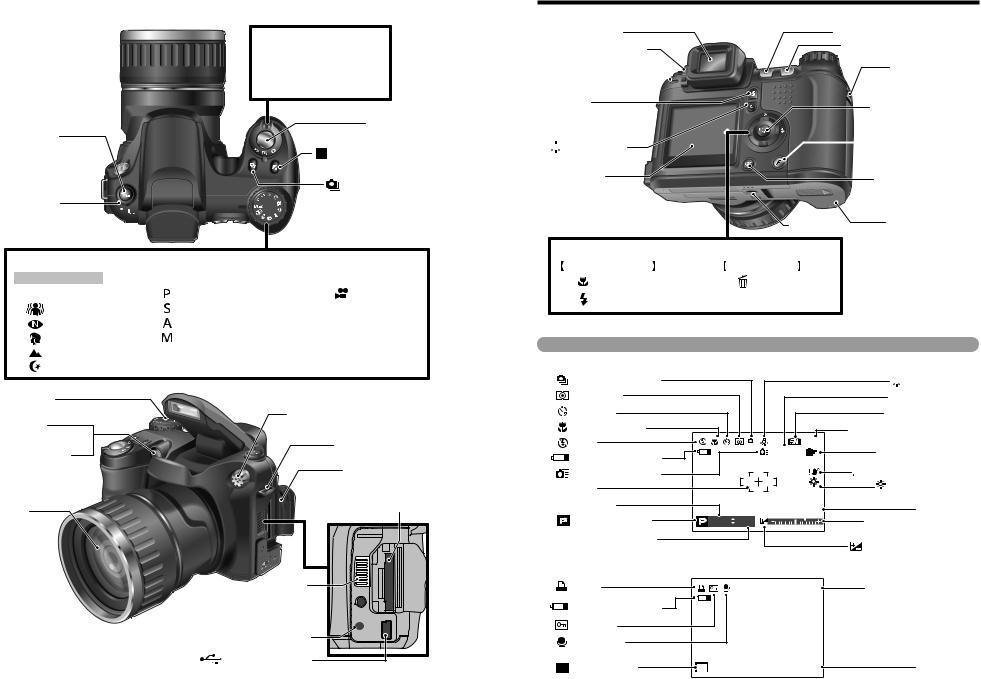
Camera parts and features |
using the camera parts or features. |
|
Refer to the pages in parentheses for information on |
|
|
Focus mode selector button (P.18)
Focus mode |
selector lock switch |
(P.18 , 21, 44-45) |
 Power switch
Power switch
 Photography mode (P.21)
Photography mode (P.21)
 Playback mode (P.28)
Playback mode (P.28)

 Power-OFF
Power-OFF
Shutter button
Exposure compensation |
button (P.43) |
Continuous shooting |
button (P.50) |
 Mode dial
Mode dial
Still Photography
 Auto (P.38)
Auto (P.38)
Anti-blur (P.38)
Natural light (P.38)
Portrait (P.38)
Landscape (P.38)
Night (P.38)
Flash (P.47)
AF-assist illuminator (P.25)
Self-timer lamp
(P.60)
Lens
|
|
Movie recording |
Programmed Auto (P.39) |
|
Movie (P.85) |
Shutter-priority Auto (P.40) |
|
|
Aperture-priority Auto (P.41) |
|
|
Manual (P.42) |
|
|
|
|
|
Microphone
Strap mount (P.10)
Slot cover (P.12)
xD-Picture Card slot (P.12)
Speaker |
A/V OUT (Audio / Visual output) socket (P.104)
socket (P.104) 
DC IN 5V (power input) socket (P.104)
USB socket (mini-B)
8
Viewfinder (EVF)
Diopter adjustment dial
Indicator lamp (P.24)
EVF/LCD |
(monitor selector) |
button (P.19, 21) |

 Low light view button (P.19, 53)
Low light view button (P.19, 53)
LCD monitor
4-direction (abd c) button (P.20)
W (Wide zoom) button (P.19, 22)
T (Tele zoom) button (P.19, 22)
Strap mount (P.10)
MENU/OK button (P.20)
 Photo mode (
Photo mode ( ) button
) button
(P.20)
DISP (display) / BACK
button (P.20, 27, 28)
Tripod mount Battery cover (P.11)
Photography mode |
Playback mode |
|
d / |
Macro button (P.46) |
a / Erase button (P.32) |
c / |
Flash button (P.47) |
|
Example of screen text display |
|
|
|
|
■ Photography mode |
|
|
|
|
Continuous shooting |
|
|
|
|
Photometry |
|
|
|
|
Self-timer |
|
|
|
|
Macro (close-up) |
|
|
|
|
Flash |
|
|
N |
12 |
Battery level warning |
|
ISO 200 |
|
|
|
|
|
|
|
High-speed shooting |
|
|
|
|
AF frame |
|
|
|
UP |
|
|
|
|
|
Shutter speed |
|
1 / 1/2005 |
12:00 AM |
|
Photography mode |
|
|||
250 |
F3.2 |
|
|
|
Aperture setting display |
|
|
|
|
■ Playback mode
DPOF |
100-0009 |
Battery level warning |
|
Protection |
|
Voice memo |
|

 White balance
White balance
ISO 200 Sensitivity
 N Quality mode Number of available frames
N Quality mode Number of available frames
 FinePix COLOR
FinePix COLOR


 Camera shake warning
Camera shake warning
UP Increasing monitor brightness Date / Time
Exposure compensation indicator
Exposure compensation
Playback frame number
Playback mode |
1 / 1/2005 |
12:00 AM |
Date / Time |
9 |
|
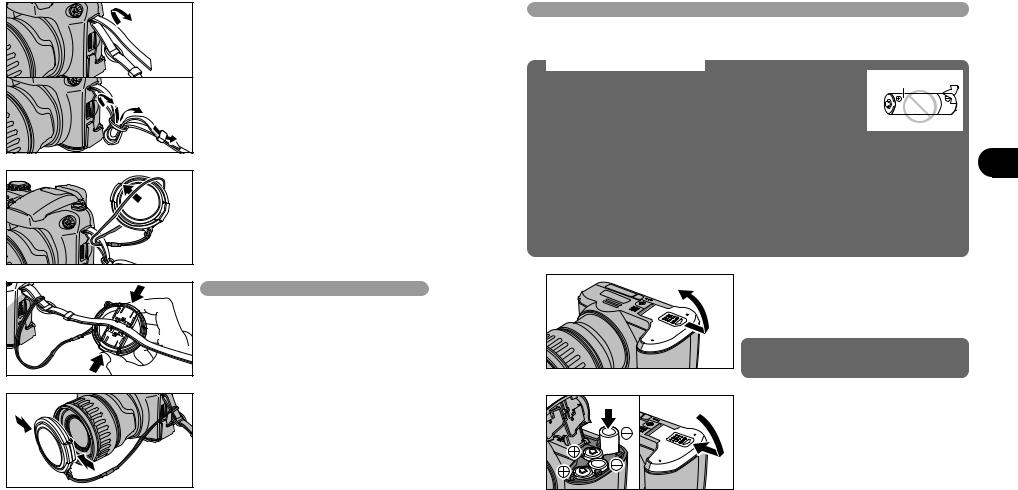
1 Getting Ready |
STRAP / ATTACHING THE LENS CAP |
|
LOADING THE BATTERIES |
1 |
Attach the shoulder strap to the strap mounts on |
Compatible batteries |
|
the camera. Once you have attached both ends of |
hAA-size alkaline batteries (4) or AA-size Ni-MH rechargeable batteries (4) (sold separately) |
||
the strap, check carefully to make sure that the |
|||
|
strap is firmly secured. |
●! Use the same brand and grade AA-size alkaline batteries as those supplied with the camera. |
|
|
|
How to use the batteries |
|
|
|
hNever use the following types of batteries, as they could cause serious |
Outer casing |
|
|
problems such as battery fluid leakage or overheating: |
|
|
|
|
|
|
|
1. Batteries with split or peeling outer casings |
|
|
|
2. Combinations of different types of batteries or new and used batteries |
|
|
|
together |
|
|
|
hDo not use manganese or Ni-Cd batteries. |
|
|
Attach the strap correctly to prevent dropping the camera. |
hSoil, such as fingermarks on the poles of the batteries can shorten time for which the batteries can be |
|
|
used. |
|
|
|
|
|
|
2 |
|
hThe time for which AA-size alkaline batteries (referred to hereafter simply as alkaline batteries) can |
|
Pull the lens cap cord through the strap. |
be used varies depending on the brand. Some brands of alkaline batteries may stop providing power |
||
|
more quickly than those supplied with the camera. Note also that due to their nature, the time for |
||
|
which alkaline batteries can be used decreases in cold conditions (0°C to +10°C/+32°F to +50°F). |
||
|
|
The use of AA-size Ni-MH batteries is better for this reason. |
|
|
|
hUse Fujifilm Battery charger (sold separately) to charge AA-size Ni-MH batteries. |
|
|
|
hSee P.118-119 for other notes on using batteries. |
|
|
|
hWhen first purchased or if left unused for a long period, the amount of time which AA-size |
|
|
|
Ni-MH batteries can be used may be short. See P.119 for more information. |
|
●! Attach the lens cap cord to prevent losing the lens cap.
3 |
Attaching the lens cap |
1 |
Check that the camera is turned off (set the Power |
switch to “OFF”) before opening the battery cover. |
|||
|
●! If opening the battery cover while the camera is still on, the |
||
|
|
|
camera will turn off. |
|
|
|
●! Do not apply force to the battery cover. |
|
|
|
Do not open the battery cover while the camera is |
|
|
|
on. This could damage the xD-Picture Card or ruin |
|
|
|
the image files on the xD-Picture Card. |
Attach the lens cap to the lens by pressing in on both sides of the cap.
2 01 |
0203 |
1Load the batteries correctly as indicated by the polarity icons.
2Press on the battery cover to push the batteries down.
3Slide the battery cover closed.
1
Ready Getting
10 |
11 |
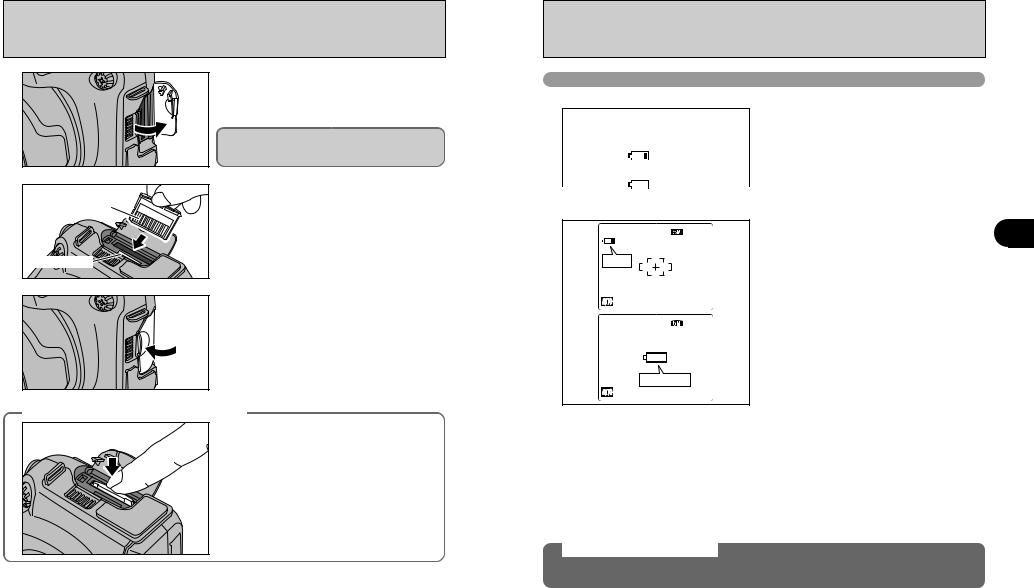
INSERTING THE xD-Picture Card
1 |
Set the Power switch to “OFF”. Open the slot |
|
cover. |
||
|
||
|
●! If opening the slot cover while the camera is still on, the |
Do not open the slot cover while the camera is on. This could damage the media or ruin the image files on the media.
2 |
Gold |
contact |
|
|
area |
|
Gold marking |
marking on the xD-Picture Card slot contact area on the xD-Picture Card
and push the card firmly all the way into the slot.
●! If the the way xD-
3 |
Close the |
|
How to replace the xD-Picture Card
Push the xD-Picture Card into the slot and then slowly remove your finger. The lock is released and the xD-Picture Card is pushed out.
N |
12 |
Lit red
N |
12 |
Blinking red
1There is ample battery charge.
2There is insufficient charge left in the batteries. The batteries will soon run out. Have a new set of batteries ready.
3The batteries are depleted. The display will shortly go blank and the camera will stop working. Replace or recharge the batteries.
“C” appears as a small icon on the left-hand side of the screen. “V” appears as a large icon in the center of the screen.
●! Depending on the camera mode and the type of batteries used, the transition from “C” to “V” may occur more quickly.
●! Due to the nature of the battery, the battery level warning may appear early when the camera is used in cold locations. This is normal. Try warming the batteries in your pocket or a similar location before use.
Battery level warning
1)The camera’s estimation of the remaining battery charge varies greatly depending on the camera operation mode. Consequently, even if “C” or “V” is not displayed in Playback mode, one of them may appear when you change to Photography mode.
2)Depending on the battery type and the level of charge in the batteries, the camera may run out of power without first displaying a battery level warning. This is particularly likely to happen when batteries that have run out of charge once are re-used.
In situation 2), immediately load new or fully charged replacement batteries.
Auto power off function
If the camera is left unused for 2 or 5 minutes, the Auto power off function turns the camera off ( P.96).
To turn the camera back on, set the Power switch to “OFF” briefly and then back to “q” or “w”.
1
Ready Getting
12 |
13 |

TURNING ON AND OFF / SETTING THE DATE AND TIME
To turn the camera on, set the Power switch to “q” 1 or “w”.
To turn the camera off, set the Power switch to “OFF”.
2 |
DATE/TIME NOT SET |
|
|
When using the camera for the first time after |
|
|
|
purchasing, the date and time are cleared. |
|||
|
|
|
|||
|
|
|
|
|
Press the “MENU/OK” button to set the date and |
|
|
|
|
|
time. |
|
SET |
NO |
|
|
|
|
|
|
|
|
●! The message also appears when the batteries have been |
|
|
|
|
|
removed and the camera has been left for a long period. |
|
|
|
|
|
●! To set the date and time later, press the “DISP/BACK” button. |
|
|
|
|
|
●! If you do not set the date and time, this message will appear |
|
|
|
|
|
each time you turn the camera on. |
3 |
DATE/TIME |
|
|
|
1Press “d” or “c” to select Year, Month, Day, |
|
|
|
Hour or Minute. |
||
|
2007 |
|
|
||
|
|
|
|
2Press “a” or “b” to correct the setting. |
|
|
|
2006 |
|
|
|
|
|
|
|
|
|
|
YY. MM . DD |
2005 1 1 |
12 |
00 |
|
|
|
2004 |
|
AM |
|
|
|
2003 |
|
|
|
|
SET |
CANCEL |
|
|
|
|
01 |
02 |
|
|
|
|
|
|
|
|
●! Holding down “a” or “b” changes the numbers continuously. |
|
|
|
|
|
●! When the time displayed passes “12”, the AM/PM setting |
|
|
|
|
|
changes. |
4 |
DATE/TIME |
|
|
|
the |
|
|
|
|
||
|
|
|
|
|
|
|
|
|
|
02 |
or |
|
|
|
|
01 |
|
|
YY. MM . DD |
2005. 7.24 |
10 |
00 |
|
|
|
|
AM 59 |
|
|
|
|
|
|
58 |
|
|
SET |
CANCEL |
|
|
|
|
|
|
|
|
●! At the time of purchase and after leaving the camera for a |
|
|
|
|
|
long period with the batteries removed, settings such as the |
|
|
|
|
|
date and time are cleared. Once the AC power adapter has |
|
|
|
|
|
been connected or the batteries have been installed for 2 |
|
|
|
|
|
hours or more, the camera settings will be retained for |
|
|
|
|
|
roughly 6 hours even if both sources of power are removed. |
14
CORRECTING THE DATE AND TIME / CHANGING THE DATE FORMAT
1 |
|
|
Press the “MENU/OK” button to display the menu |
|
|
on the screen. |
|
|
|
|
|
SELF-TIMER |
|
|
|
1 |
OFF |
|
|
: |
|
|
|
|
: AUTO |
OFF |
|
2 |
: OFF |
|
|
: |
|
|
|
|
|
|
|
|
: SET |
|
|
2 01 |
|
02 |
1Press “a” or “b” to select “˜” SET-UP. |
|
2Press “c”. |
||
|
|
SET-UP |
|
|
: OFF |
|
|
1 |
: |
|
|
|
: AUTO |
|
|
2 |
: OFF |
|
|
: |
|
|
|
|
SET |
|
|
|
|
|
|
3 01 |
|
02 |
1Press “d” to move to page number. |
|
2Press “a” or “b” to select “PAGE 3”. |
||
PAGE 3 |
|
|
|
1 |
: SET |
|
|
: SET |
|
|
|
2 |
|
|
|
: ENGLISH |
|
|
|
3 |
: SET |
|
|
: |
|
|
|
4 |
|
|
|
: NTSC |
|
|
|
4 01 03 |
|
02 |
1Press “c” to move to menu item. |
|
2Press “a” or “b” to select “ì” DATE/TIME. |
||
|
|
|
3Press “c”. |
|
|
DATE/TIME |
|
1 |
: SET |
SET |
|
|
|
||
2 |
|
|
|
: ENGLISH |
|
|
|
3 |
: SET |
|
|
: |
|
|
|
4 |
|
|
|
: NTSC |
|
|
|
|
|
|
Continued |
1
Ready Getting
15
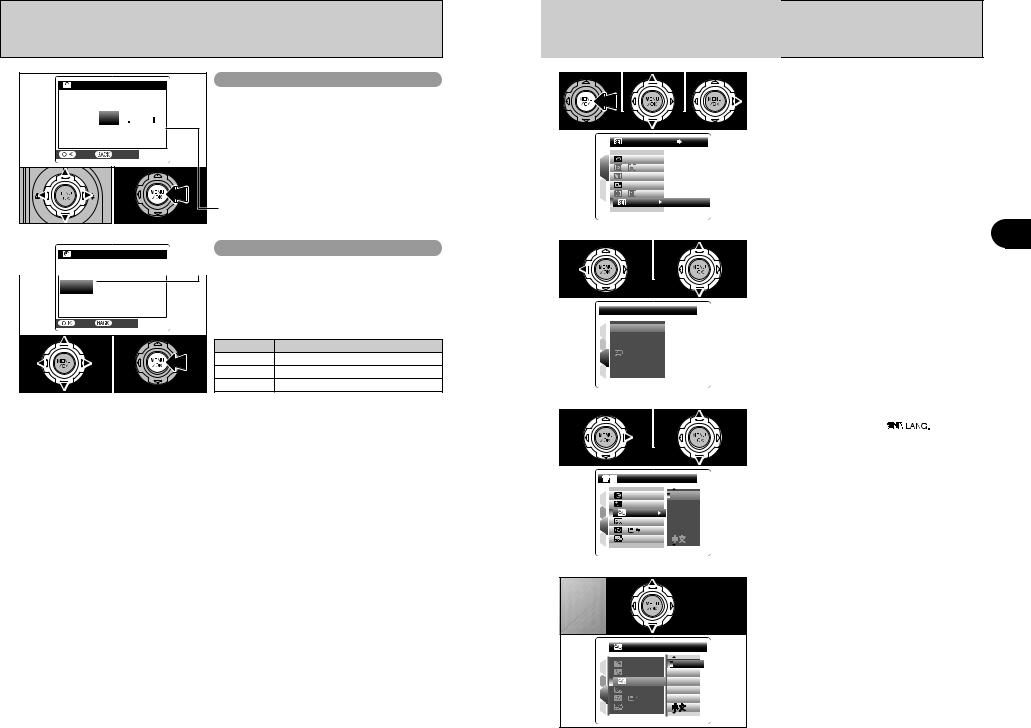
CORRECTING THE DATE AND TIME / CHANGING THE DATE FORMAT
5 |
DATE/TIME |
|
|
|
|
Correcting the date and time |
|
|
|
|
|
|
|
||
|
2007 |
|
|
|
1Press “d” or “c” to select Year, Month, Day, |
||
|
|
2006 |
|
|
|
Hour or Minute. |
|
|
YY. MM . DD |
2005 |
7 24 |
12 |
00 |
||
|
2Press “a” or “b” to correct the setting. |
||||||
|
|
2004 |
|
|
AM |
||
|
|
|
|
3Always press the “MENU/OK” button after the |
|||
|
|
2003 |
|
|
|
||
|
SET |
CANCEL |
|
|
settings are completed. |
||
|
|
|
|
|
|||
|
01 02 |
|
03 |
|
|
|
|
|
|
|
|
|
|
●! Holding down “a” or “b” changes the numbers continuously. |
|
|
|
|
|
|
|
●! When the time displayed passes “12”, the AM/PM setting |
|
|
|
|
|
|
|
changes. |
|
|
DATE/TIME |
|
|
|
|
Changing the date format |
|
|
|
|
|
|
|
|
|
|
DD. M M . YY |
|
|
|
|
1Press “d” or “c” to select the date format. |
|
|
|
|
|
|
2Press “a” or “b” to set the format. Refer to the |
||
|
MM/DD/YY |
7/24/2005 |
10:00 |
table below for details of the settings. |
|||
|
Y Y. M M . DD |
|
|
|
AM |
||
|
|
|
|
3Always press the “MENU/OK” button after the |
|||
|
|
|
|
|
|
||
|
SET |
CANCEL |
|
|
settings are completed. |
||
|
|
|
|
|
|||
|
01 02 |
|
03 |
|
|
Date format |
Sample settings |
|
|
|
|
|
|
YY.MM.DD |
2005.7.24 |
|
|
|
|
|
|
MM/DD/YY |
7/24/2005 |
|
|
|
|
|
|
DD.MM.YY |
24.7.2005 |
16
SELECTING THE LANGUAGE
1 10 |
02 |
30 |
1Press the “MENU/OK” button to display the menu on the screen.
2Press “a” or “b” to select “˜” SET-UP. 3Press “c”.
|
|
|
SET-UP |
|
|
|
: OFF |
|
|
|
1 |
: |
|
|
|
|
: AUTO |
|
|
|
2 |
: OFF |
|
|
|
: |
|
|
|
|
|
|
|
|
|
|
SET |
|
|
2 |
PAGE 3 |
20 |
1Press “d” to move to page number. |
1 |
2Press “a” or “b” to select “PAGE 3”. |
ReadyGetting |
|||
01 |
|
1 
 : SET
: SET  : SET
: SET
2 : ENGLISH
: ENGLISH
:SET
3 :
: 

4 : NTSC
: NTSC
3 01 03 |
20 |
1Press “c” to move to menu item. |
|
2Press “a” or “b” to select |
”. |
||
|
|
3Press “c”. |
|
|
/LANG. |
|
||
1 |
: |
SET |
ENGLISH |
|
: SET |
FRANCAIS |
|||
2 |
||||
|
:ENGLISH |
DEUTSCH |
||
3 |
: |
SET |
ESPAÑOL |
|
: |
|
ITALIANO |
||
|
|
|||
4 |
: NTSC |
|
||
●! The screens in this manual are shown in English.
●! See P.92 for more information on the “˜” SET-UP menu.
4 |
|
|
Press “a” or “b” to select the language. |
|
|
|
|
||
|
|
|
ENGLISH |
|
1 |
: |
SET |
ENGLISH |
|
: SET |
FRANCAIS |
|||
2 |
||||
|
:ENGLISH |
DEUTSCH |
||
3 |
: |
SET |
ESPAÑOL |
|
: |
|
ITALIANO |
||
|
|
|||
4 |
: NTSC |
|
||
|
|
|
17 |
|
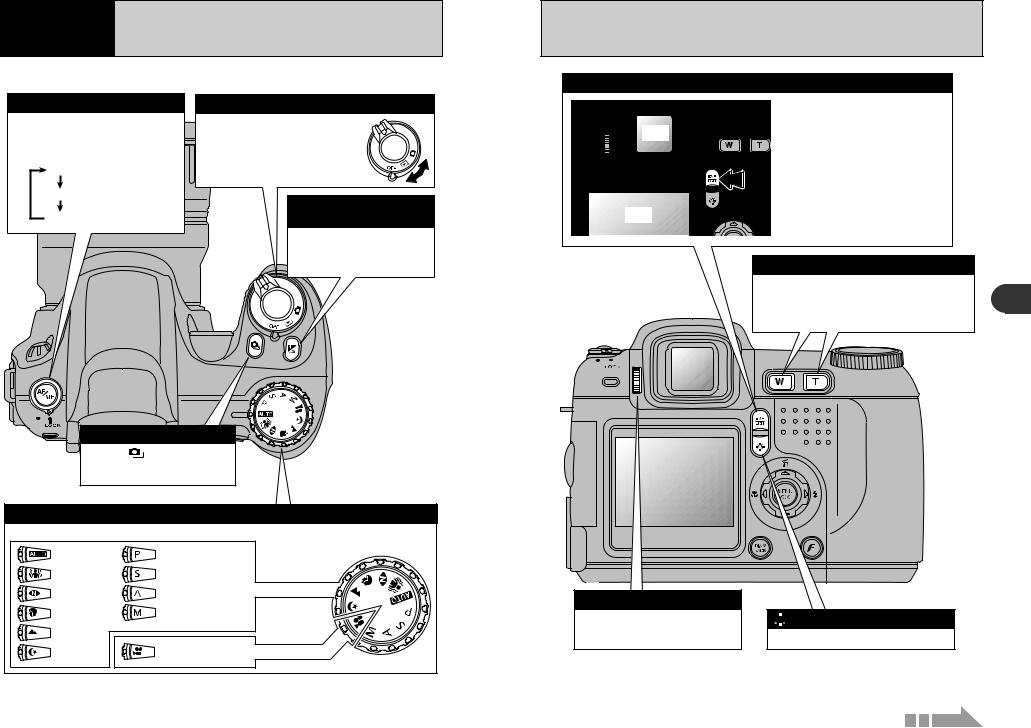
2 Using
the Camera BASIC OPERATION GUIDE
This section describes the camera’s functions.
Focus mode selector button
Unlock using the Focus mode selector lock switch. Press the Focus mode selector button to change the focus mode.
Focus mode
S-AF : Single AF
MF : Manual focus
C-AF : Continuous AF
Power switch
ON/OFF and
“  ” Photography mode / “
” Photography mode / “  ” Playback mode selector switch
” Playback mode selector switch
Use the Power switch to select the mode.
Exposure compensation button
With the “ ” button held down,
” button held down,
press the “d” or “c” button to select the exposure compensation.
Continuous shooting button
With the “ ” button held down, press “d” or “c” to select the Continuous shooting mode.
” button held down, press “d” or “c” to select the Continuous shooting mode.
Photography mode selector
Turn the Mode dial to select the Photography mode.
Auto |
Programmed Auto |
|
Anti-blur |
Shutter-priority Auto |
|
Natural light |
Aperture-priority Auto |
Still Photography |
Portrait |
Manual |
|
Landscape |
|
|
Night |
Movie |
Movie recording |
EVF/LCD (monitor selector) button
EVF
LCD
Diopter adjustment dial
Makes the image in the viewfinder easier to see. Set the dial to the position where the AF frame appears sharpest.
Pressing the “EVF/LCD” button toggles between the viewfinder (EVF) and the LCD monitor. Use whichever mode is best suited to your shot.
Zoom button
Photography: Press “T” to zoom in (telephoto). Press “W” to zoom out (wide-angle).
Playback: Press “T” to enlarge the image. Press “W” to revert to normal display.


 Low light view button
Low light view button
The screen brightness is increased briefly.
2
Camera the Using
18 |
Continued |
19 |
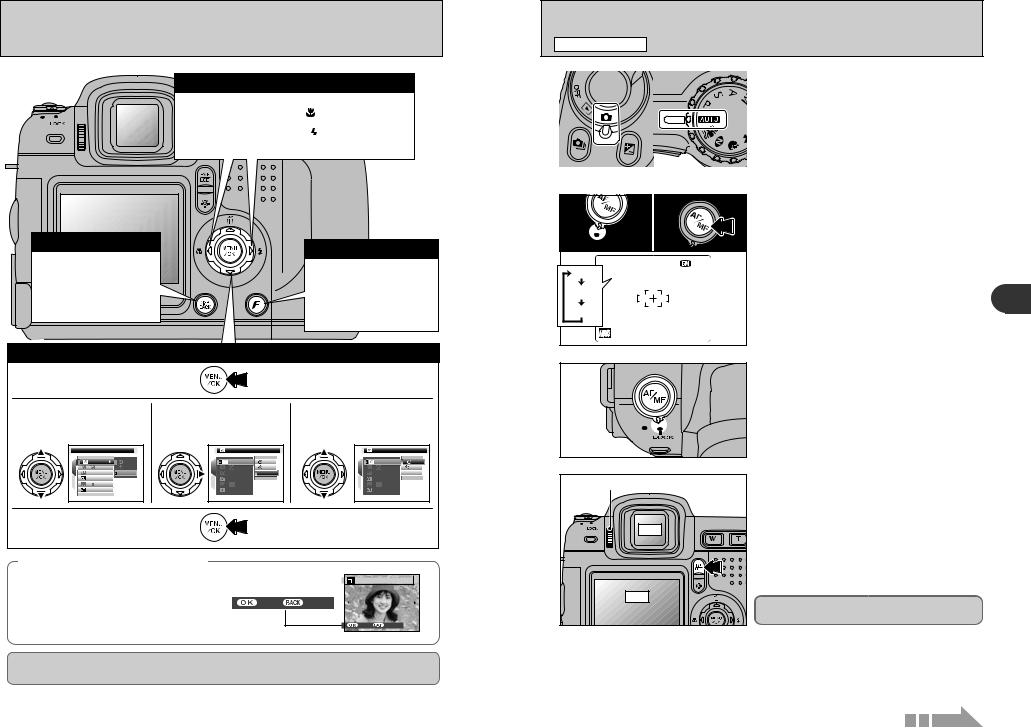
BASIC OPERATION GUIDE
dc button
Photography: d button
Turns Macro ( ) on and off. c button
Sets the flash ( ).
).
Playback: Change frame or movie frame advance.
DISP/BACK button
DISP: Press this button to select the screen display.
BACK: Press this button to stop a procedure midway through.
Photo mode button
button
Photography: Select the quality mode, sensitivity and FinePix COLOR settings.
Playback: Specify the print order (DPOF) settings.
Using the Menus
1Displaying the menu.
Press the “MENU/OK” button.
2Selecting a menu option. |
3Selecting an option. |
4Selecting a setting. |
Press the up or down arrow |
Press the right arrow on the |
Press the up or down arrow on |
on the 4-direction button. |
4-direction button. |
the 4-direction button. |
SELF-TIMER |
|
|
|
|
OFF |
|
10 SEC |
|
1 |
: OFF |
|
|
: OFF |
|
|
: OFF |
|
: |
|
1 |
: |
|
1 |
: |
|
|
|
: AUTO |
OFF |
|
: AUTO |
OFF |
|
: AUTO |
OFF |
2 |
: OFF |
|
2 |
: OFF |
|
2 |
: OFF |
|
: |
|
: |
|
: |
|
|||
|
: SET |
|
|
: SET |
|
|
: SET |
|
5Confirming the setting.
Press the “MENU/OK” button.
Displaying the on-screen Help |
|
|
|
Instructions for the next step in the procedure |
|
ERASE OK? |
|
appear at the bottom of the screen. Press the |
|
|
|
|
|
|
|
button indicated. |
YES |
CANCEL |
|
In the right side screen, press the “MENU/OK” |
|
||
|
|
|
|
button to erase the displayed frame. To cancel |
|
YES |
CANCEL |
erasing, press the “DISP/BACK” button. |
|
|
|
Up, down, left and right are indicated by black triangles in the Owner’s Manual. Up or down is shown as “a” or “b”, and left or right is shown as “d” or “c”.
PHOTOGRAPHY MODE TAKING PICTURES (AUTO MODE)
1 10 |
20 |
1Set the Power switch to “q”. |
2Set the Mode dial to “B”. |
h Focal range
Wide-angle: approx. 90 cm (3.0 ft.) to infinity Telephoto: approx. 2 m (6.6 ft.) to infinity
●! Use Macro mode for subjects closer than 90 cm (3.0 ft.) ( P.46).
●! When [CARD ERROR], [CARD NOT INITIALIZED], [CARD FULL] or [NO CARD] appears, see P.123.
2 01 |
|
02 |
1Unlock the Focus mode selector lock switch. |
|
2Press the Focus mode selector button to set the |
||
|
|
|
Focus mode to “S-AF”. |
S - AF |
S - AF |
N 12 |
|
|
|||
MF |
|
|
|
C - AF |
|
|
|
|
2000 |
F2 8 |
●! See P.44-45 for information on the manual focus “MF” and |
|
|
|
the continuous AF “C-AF”. |
3 |
|
|
lock switch to |
|
|
|
|
4 |
Diopter adjustment dial |
Press the “EVF/LCD” button to alternate the display |
|
viewfinder (EVF) and the LCD |
|||
|
|||
|
|
||
|
|
the “EVF/LCD” button to select the |
|
|
|
. |
|
|
EVF |
frame in the viewfinder (EVF) is |
|
|
adjust the viewfinder using the |
||
|
|
||
|
|
dial. |
|
|
LCD |
The EVF/LCD selection is retained even when the |
|
|
|
||
|
|
camera is off or the mode setting is changed. |
2
Camera the Using
20 |
Continued |
21 |
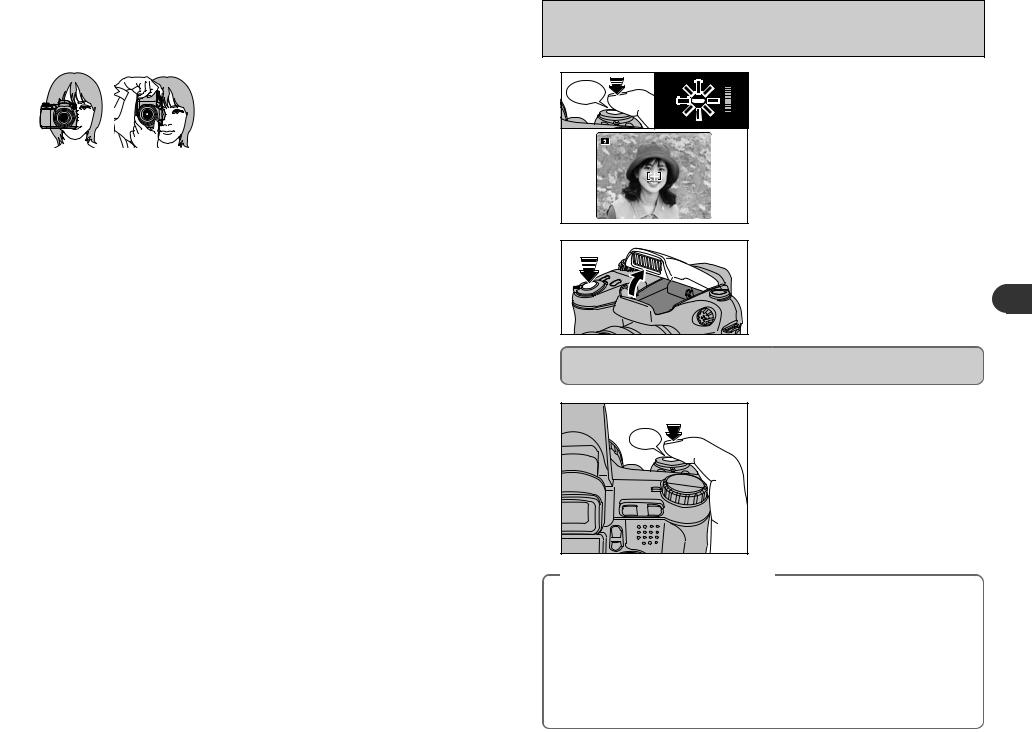
|
PHOTOGRAPHY MODE TAKING PICTURES (AUTO MODE) |
|
5 |
Brace your elbows against your sides and hold the |
|
camera with both hands. Position your right thumb |
||
|
||
|
so that it is handy for using the zoom. |
●! Moving the camera while shooting gives a blurred picture (camera shake). Use a tripod to prevent camera shake, particularly for shots in the dark when the selected flash mode is Suppressed flash.
●! There may be some uneven brightness at the lower edge of the screen. This is normal and does not affect the photographed image.
6 |
Hold the camera so that your fingers or the strap do |
|
not cover the lens, flash and AF-assist illuminator. |
||
|
||
|
If the lens, flash or AF-assist illuminator is obscured |
|
|
by your fingers or the strap, subjects may be out of |
|
|
focus or the brightness (exposure) of your shot may |
|
|
be incorrect. |
●! Check that the lens is clean. If it is dirty, clean the lens as informed on P.118.
●! If the flash is used in dusty conditions or when it is snowing, white dots may appear in the image due to flash reflecting off the dust particles or snowflakes. Use Suppressed flash mode to fix the problem.
7 |
|
|
N 12 |
Zoom bar |
|
2000 |
F2 8 |
8 |
N 12 |
|
|

 AF frame
AF frame
Press “T” (telephoto) button to zoom in. Press “W” (wide-angle) button to zoom out. A zoom bar appears on the screen.
hOptical zoom focal length
(35 mm camera equivalent)
Approx. 38 mm to 380 mm
(„: Approx. 39.5 mm to 395 mm) Max. zoom scale: 10×
●! See P.95 for information on procedures for using digital zoom.
Frame the shot so that the subject fills the entire AF (Autofocus) frame.
●! The image shown on the screen before the picture is taken may differ in brightness, color, etc. from the image actually recorded. Play back the recorded image to check it ( P.28).
●! When the subject is not in the AF frame, use AF/AE lock to take the picture ( P.26).
Compatible filters
55 mm-diameter commercial available filters can be attached.
●! Do not use more than one filter at a time.
●! The lens cap (included) may not be used when attaching the filter.
22
9 |
|
Press the shutter button down halfway. When a |
|
Bebeep |
short double-beep is heard, the camera focuses on |
|
|
your subject. The AF frame on the screen becomes |
|
||
|
|
|
|
|
|
smaller and the camera sets the shutter speed and |
|
|
|
aperture. The indicator lamp (green) changes from |
|
|
|
blinking to lit. |
|
|
|
●! When a short double-beep is not heard and “{” appears on |
|
|
|
the screen, the camera cannot focus. |
|
|
|
●! Pressing the shutter button down halfway freezes the image |
|
|
|
on the screen briefly. This image is not the recorded image. |
|
|
|
●! When “{” appears on the screen, press again the shutter |
|
|
250 F3.2 |
button down halfway or try standing about 2 m (6.6 ft.) from |
|
|
|
your subject to take the picture. |
|
|
|
Pressing the shutter button halfway when the flash |
|
|
|
is not popped up, camera pops the flash up as |
|
|
|
required by the shooting conditions. |
|
|
|
|
2 |
|
Before the flash fires, “∑” appears on the screen. When selecting a slow shutter speed that will |
the Using |
|
|
cause camera shake, “|” appears on the screen. Use the flash to take pictures. According to the |
Camera |
|
|
scene or mode being shot, use a tripod. |
|
|
|
|
|
|
10 |
|
Press the shutter button down fully. When a |
|
|
clicking sound is heard, the camera records the |
|
|
|
|
|
|
|
Click |
image. |
|
|
●! There is a slight delay between the shutter button being |
|
|
|
|
|
|
|
|
pressed and the picture being taken. Play back the shot to |
|
|
|
check the image. |
|
|
|
●! When pressing the shutter button down fully in one motion, |
|
|
|
the camera takes the picture without the AF frame changing. |
|
|
|
●! When taking a picture, the indicator lamp lights orange |
|
|
|
(shooting disabled). The indicator lamp then turns green and |
|
|
|
the next picture can be taken. |
|
|
|
●! When taking a picture using flash, the image may disappear |
|
|
|
and go dark briefly due to flash charging. The indicator lamp |
|
|
|
blinks orange during charging. |
|
|
|
●! See P.123-124 for information on the warning displays. |
|
Subjects not suitable for autofocus
The FinePix S5200 / FinePix S5600 uses a high-precision autofocusing mechanism. However, it may have difficulty focusing on the following:
h Very shiny subjects such as a mirror or car body
h Subjects photographed through glass
h Subjects that do not reflect well, such as hair or fur
h Subjects with no substance, such as smoke or flames
h Dark subjects
h Fast moving subjects
h Subjects with little or no contrast between the subject and the background (such as white
walls or subjects dressed in the same color as the background)
h Shots where another high-contrast object (not |
|
the subject) is close to the AF frame and is |
|
either closer or further away than your subject |
|
(such as a shot of someone against a |
|
background with strongly contrasting |
|
elements) |
|
For such subjects use AF/AE lock ( P.26) or |
|
“MF” Manual focus mode ( P.45). |
23 |
|
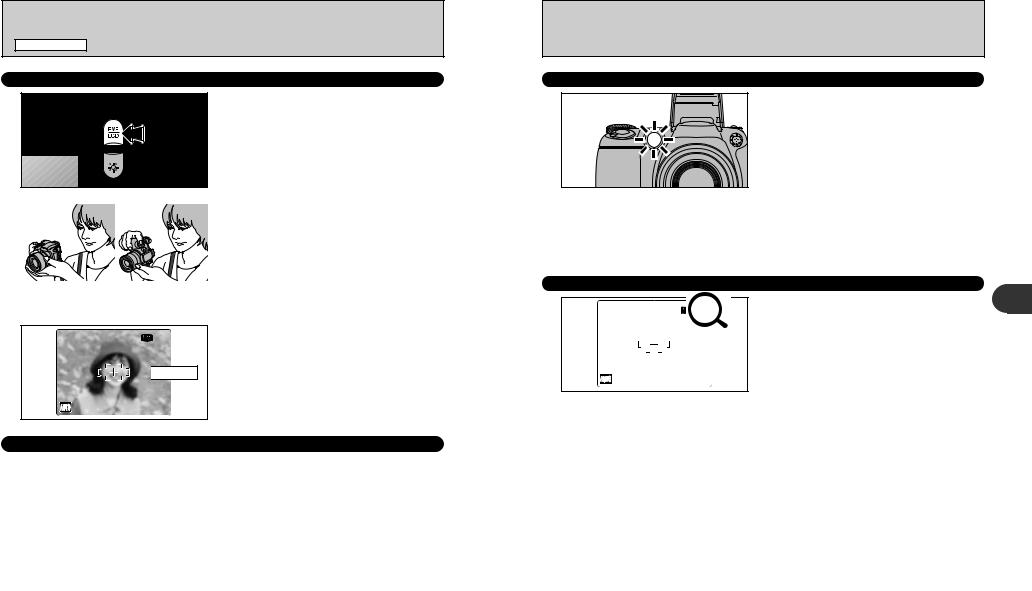
PHOTOGRAPHY MODE TAKING PICTURES (AUTO MODE)
USING LCD MONITOR
When using the LCD monitor to take pictures, 1 press the “EVF/LCD” button to select the LCD
monitor.
3 |
N 12 |
|

 AF frame
AF frame
Frame the shot so that the subject fills the entire AF (Autofocus) frame.
●! The image shown on the LCD monitor before the picture is taken may differ in brightness, color, etc. from the image actually recorded. Play back the recorded image to check it ( P.28).
●! When the subject is not in the AF frame, use AF/AE lock to take the picture ( P.26).
INDICATOR LAMP DISPLAY
AF-ASSIST ILLUMINATOR
Press the shutter button down halfway in dimly lit conditions. The camera fires the AF-assist illuminator (green) to allow easier focusing.
Note that the effective range decreases for telephoto shots.
●! Even when the AF-assist illuminator fires, the camera may have difficulty focusing in some conditions.
●! Even though there is no danger to safety, do not expose it directly in someone’s eyes from a short distance.
●! The camera focuses most easily when a picture is taken at a distance of around 3.2 m (10.5 ft.) with wide-angle and 2.4 m (7.9 ft.) with telephoto.
●! When using the AF-assist illuminator in Macro mode, the camera may have difficulty focusing to take close-up shots.
●! See P.92 for information on turning the AF-assist illuminator off.
Camera the Using
|
|
|
|
|
|
|
|
|
|
|
|
|
|
|
|
|
|
|
|
|
|
|
|
|
|
|
|
|
|
|
|
|
|
|
|
|
|
|
|
|
|
|
|
|
|
|
|
|
|
|
|
|
|
|
|
|
|
|
|
|
|
|
|
|
|
|
|
|
|
|
|
|
|
|
|
|
|
|
|
|
|
|
|
|
|
|
|
|
|
|
|
|
|
|
|
|
|
|
|
|
|
|
|
|
|
|
|
|
|
|
|
|
|
|
|
|
|
|
|
|
|
|
|
|
|
|
|
|
|
|
|
|
|
|
|
|
|
|
|
|
|
|
|
|
|
|
|
|
|
|
|
|
|
|
|
24 |
|
|
|
25 |
||||||||
|
|
|
||||||||||
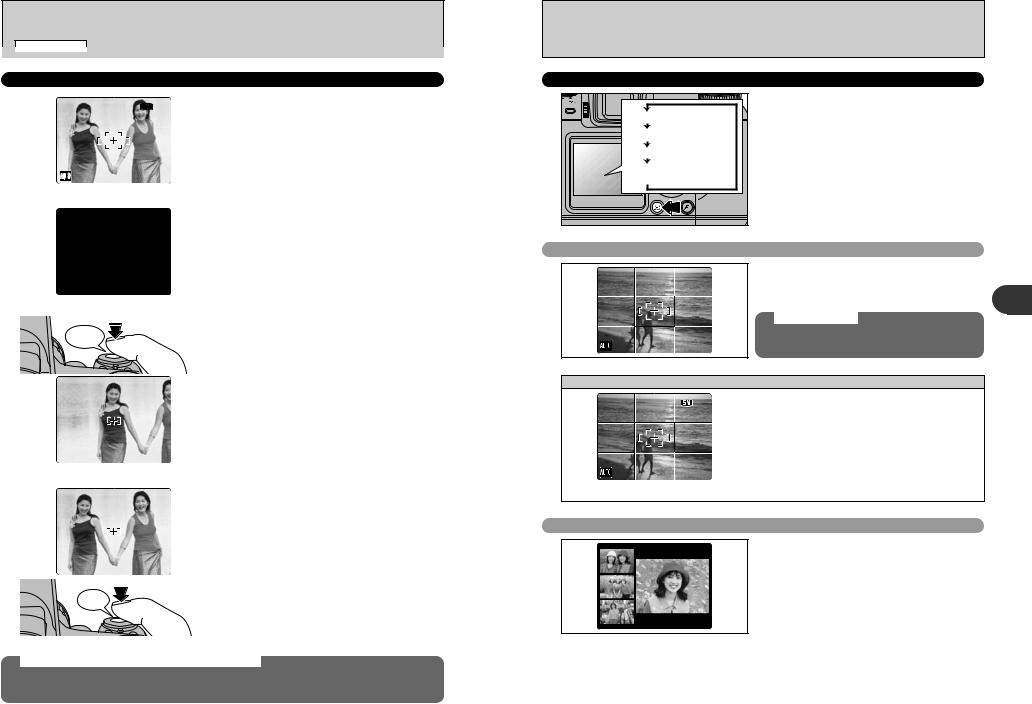
PHOTOGRAPHY MODE TAKING PICTURES (AUTO MODE)
USING AF/AE LOCK
1 |
N |
12 |
In this shot, the subjects (two people in this case) |
|
are not in the AF frame. Taking the picture at this |
||||
|
point will result in the subjects being out of focus.
2 |
N 12 |
Move the camera slightly so that one of the |
|
subjects is in the AF frame. |
|||
|
3 |
|
Press the shutter button down halfway (AF/AE |
Bebeep |
lock). When a short double-beep is heard, the |
|
|
camera focuses on your subject. The AF frame on the screen becomes smaller and the camera sets the shutter speed and aperture. The indicator lamp (green) changes from blinking to lit.
250 F3.2
Continue to hold the shutter button down halfway. 4 Move the camera back to the original image and
press the shutter button fully.
250 F3.2
Click |
●! AF/AE lock can be applied repeatedly before the shutter is |
|
released. |
|
●! Use AF/AE lock in all Photography modes to guarantee |
|
excellent results. |
AF (Autofocus)/AE (Auto-exposure) lock
On the FinePix S5200 / FinePix S5600, pressing the shutter button down halfway locks the focus and exposure settings (AF/AE lock). To focus on a subject that is off to one side or to set the exposure before composing the final shot, lock the AF and AE settings. Then take the picture to get the best result.
SHOOTING ASSISTANT FUNCTION
Text displayed |
No text displayed |
Framing guideline displayed |
Post shot assist window |
displayed |
Select the framing guideline and post shot assist window in Photography mode.
Pressing the “DISP/BACK” button changes the screen display.
BEST FRAMING
 N 12
N 12
display consists of horizontal that divide the image on the
lock when composing a shot. out of focus if AF/AE lock is not
Scene
N 12
Position the main subject at the intersection of two lines in this frame or align one of the horizontal lines with the horizon. Use this frame as a guide to the subject’s size and the balance of the shot while composing a shot.
●! The framing guideline is not recorded on the image.
●! The lines in the scene frame divide the image into 3 roughly equal parts horizontally and vertically. The resulting printed image may be shifted slightly from the scene frame.
POST SHOT ASSIST WINDOW
shot assist window, the last appears as a thumbnail in the screen (post shot assist
photographed images appear on
. This serves as a guide similar compositions.
the image in the post shot assist
window:
i Setting the camera to Playback mode i Turning the camera off
i Using the PictBridge function i Using the DSC mode etc.
2
Camera the Using
26 |
27 |
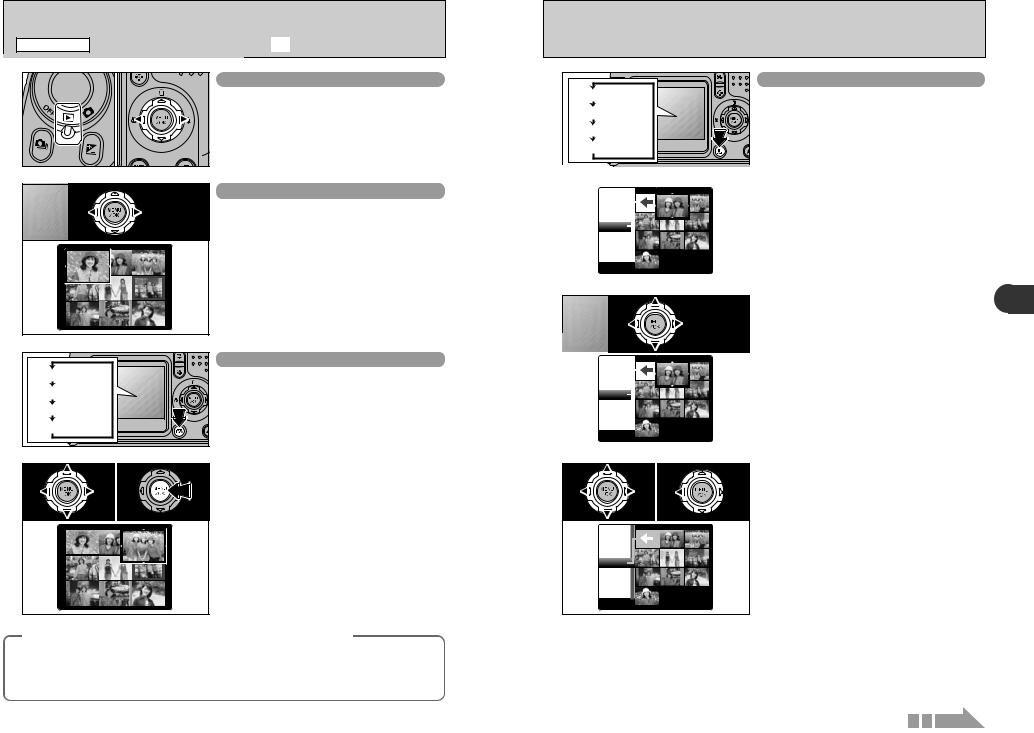
PLAYBACK MODE VIEWING THE IMAGES (wPLAYBACK)
01 |
02 |
Single-frame playback
1Set the Power switch to “w”.
2Press “c” to scan forward through the images. Press “d” to scan backwards.
●! Set the Power switch to “w” to play back the last shot.
Selecting images
To select images on the thumbnail lists screen, hold down “d” or “c” for 1 second during playback.
|
playback |
|
Text displayed |
mode, press the “DISP/BACK” button |
|
No text displayed |
display shown on the screen. Press |
|
button until the multi-frame |
||
Multi frame playback |
||
(9 frames) appears. |
||
|
||
Sorting by date |
|
01 |
02 |
(colored frame) to the selecting frame. Press “a” or “b” repeatedly to jump to the next page.
2Press the “MENU/OK” button to enlarge the image.
Still images viewable on the FinePix S5200 / FinePix S5600
This camera will display still images recorded on the FinePix S5200 / FinePix S5600 or still images (excluding some uncompressed images) recorded on any FUJIFILM digital camera that supports xDPicture Cards.
Clear playback or playback zooming may not be possible for still images shot on cameras other than the FinePix S5200 / FinePix S5600.
1 Text displayed |
|
Sorting by date |
||
|
In Playback mode, press the “DISP/BACK” button |
|||
|
No text displayed |
|
to change the display shown on the screen. Press |
|
|
|
the “DISP/BACK” button until the sorting by date |
||
|
Multi frame playback |
|
||
|
|
screen appears. |
||
|
|
|
||
|
Sorting by date |
|
|
|
|
|
|
●! Large number of images may take longer to appear. |
|
2 |
2005 |
|
Changing to Sorting by date mode displays the |
|
|
images taken on the same day as the image |
|||
|
7/17 |
|
||
|
|
selected in Multi-frame playback mode. |
||
|
7/23 |
|
|
|
|
7/24 |
|
|
|
|
1/9 |
|
|
|
3 |
|
|
Press “a”, “b”, “d” or “c” to move the cursor |
|
|
|
(colored frame) to the selecting frame. |
||
|
2005 |
|
|
|
|
7/17 |
|
|
|
|
7/23 |
|
|
|
|
7/24 |
|
|
|
|
1/9 |
|
|
|
4 |
01 |
02 |
To select the date: |
|
1Press “a”, “b”, “d” or “c” to move the cursor |
||||
|
|
|
||
|
|
|
(colored frame) to “b” on the upper left frame. |
|
|
|
|
2Press “d” to display the selecting date. |
|
|
2005 |
|
|
|
|
7/17 |
|
|
|
|
7/23 |
|
|
|
|
7/24 |
|
|
|
|
9 |
|
|
|
2
Camera the Using
28 |
Continued |
29 |
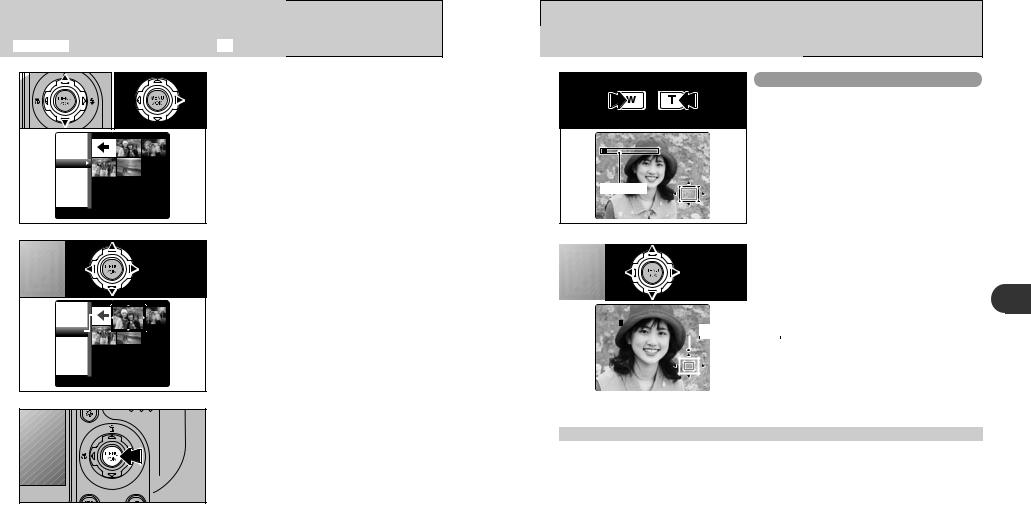
PLAYBACK MODE |
VIEWING THE IMAGES (wPLAYBACK) |
|
5 01 |
20 |
1Press “a” or “b” to move the cursor (colored |
frame) to select the date. Pressing “a” or “b” |
||
|
|
repeatedly changes to the next page. |
|
|
2Press “c” to return to “b”. |
2005 |
7/17 |
7/23 |
7/24 |
4 |
6 |
Press “a”, “b”, “d” or “c” to move the cursor |
(colored frame) to the selecting frame. |
2005 |
7/17 |
7/23 |
7/24 |
1/4 |
7 |
Press the “MENU/OK” button to enlarge the |
|
selected image. |
||
|
Zoom bar |
Playback zoom
Press the “T” or “W” button during single-frame playback to zoom the image. A zoom bar appears on the screen.
●! Playback zoom cannot be used with multi-frame playback.
Press “a”, “b”, “d” or “c” to display another part of the image.
The current displayed image appears on the navigation screen.
Navigation screen
|
|
|
|
|
|
|
|
|
|
|
●! Press the “DISP/BACK” button to cancel playback zoom. |
||
|
|
|
|
|||
|
|
|
|
|||
|
|
|
|
|||
■ Zoom scales |
|
|
|
|||
|
|
|
|
|||
Quality mode |
|
|
Max. zoom scale |
|||
|
|
|
|
|||
÷(2592 × 1944 pixels) |
|
|
Approx. 4.1× |
|||
„(2736 × 1824 pixels) |
|
|
Approx. 4.3× |
|||
3(2048 × 1536 pixels) |
|
|
Approx. 3.2× |
|||
2(1600 × 1200 pixels) |
|
|
Approx. 2.5× |
|||
2
Camera the Using
30 |
31 |
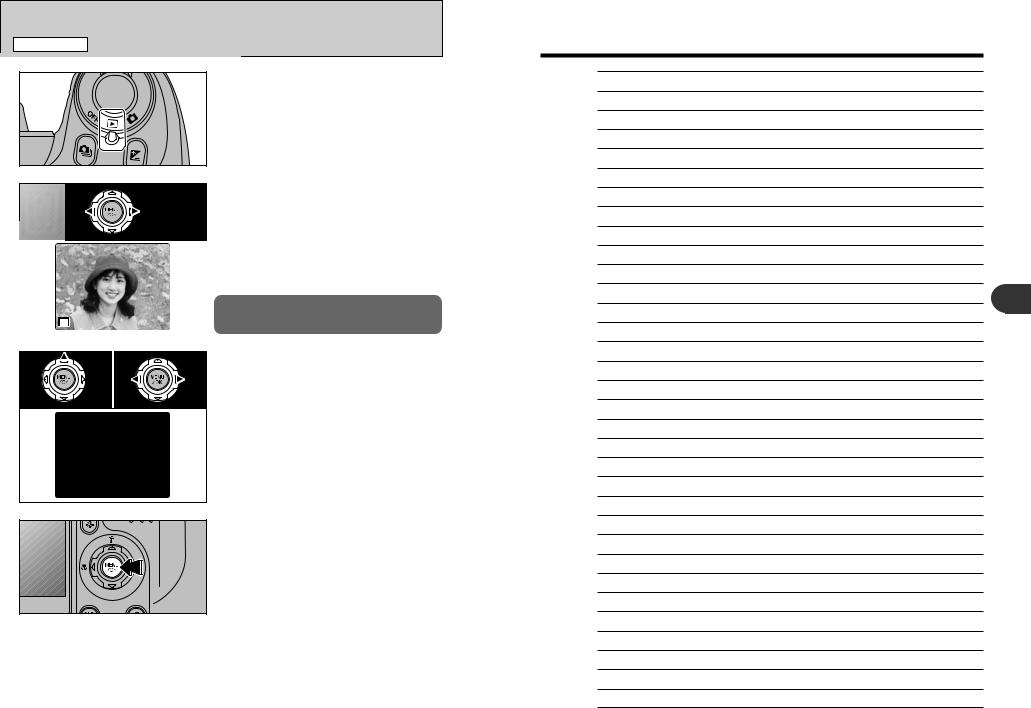
|
PLAYBACK MODE ERASING IMAGE (ERASE FRAME) |
Memo |
1 |
Set the Power switch to “w”. |
|
|
|
2 |
Press “d” or “c” to select the erasing frame (file). |
|
|
|
100-0001 |
|
7/24/2005 |
3 10 |
02 |
ERASE OK? |
|
OK |
CANSEL |
SET |
|
4
Erased frames (files) cannot be recovered. Back up important frames (files) onto your PC or another media.
2Press “d” or “c” to select “OK”.
Press the “MENU/OK” button to erase the displayed frame (file).
When erasing frames (files) is completed, camera returns to single-frame playback.
2
Camera the Using
32 |
33 |
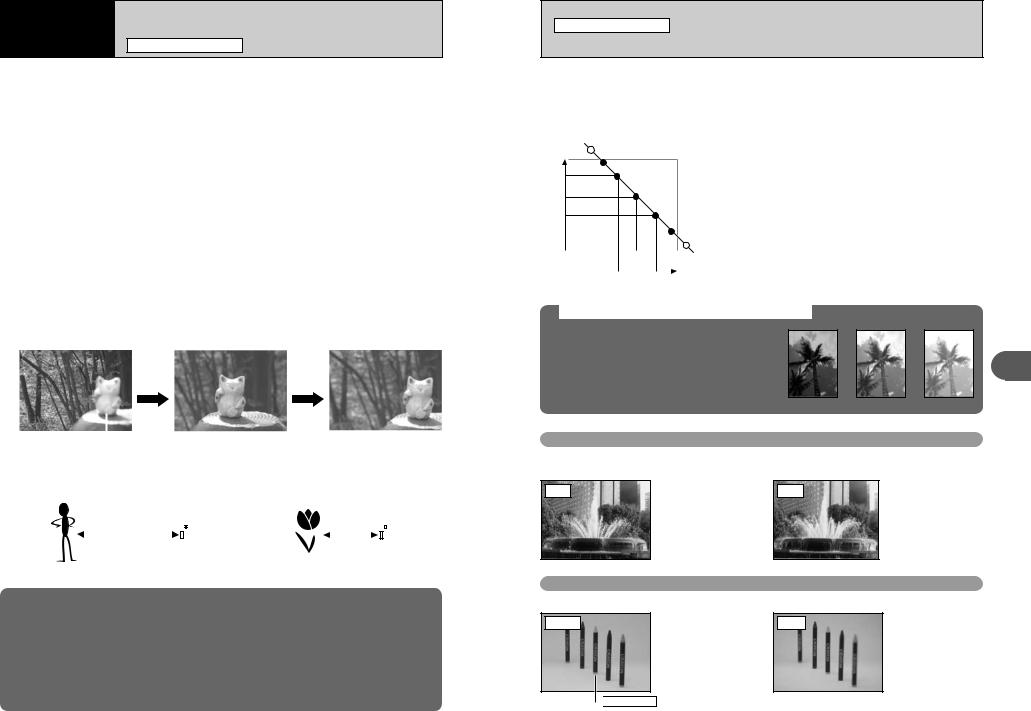
Advanced |
PHOTOGRAPHY FUNCTIONS FOCUSING (DISTANCE) |
3 Features |
The distance from the subject to the camera is referred to as the shooting distance.
When the shooting distance is set correctly and the image appears sharp, the image is focused.
■ Three focusing methods
The mechanisms for focusing are S-AF (Single AF), C-AF (Continuous AF) and MF (Manual focus).
S-AF: Use S-AF for normal photography. In this mode, the camera focuses each time the shutter button is pressed down halfway. Select the AF mode ( P.63) when the Mode dial is set to “N”, “M”, “<” or “>” mode.
C-AF: Use C-AF to photograph moving subjects. When this mode is set, the camera focuses continuously on the subject in the center of the screen. See P.44 for details.
MF: The focus is set manually. See P.45 for details.
■ Causes of focusing errors and the solutions
Cause |
Solution |
The subject is not in the AF frame. |
Use AF lock (focus mode: AF (CENTER)) 1 or MF. |
The subject is not suited to AF. |
Use AF lock (focus mode: AF (CENTER)) 1 or MF. |
|
|
The subject is outside the shooting range. |
Turn Macro mode on or off 2. |
|
|
The subject is moving too quickly. |
Use MF (pre-setting the shooting distance for a shot ) |
|
|
1 Taking pictures using AF lock
Press the shutter button down halfway to focus.
|
|
|
|
|
|
|
|
|
|
|
|
|
|
|
|
|
|
|
|
|
|
|
|
|
|
|
|
|
|
|
|
|
|
|
|
|
|
|
|
|
|
|
|
|
|
|
|
|
|
|
|
|
|
|
|
|
|
|
|
|
|
|
|
|
|
|
|
|
|
|
|
|
|
|
|
|
|
|
|
|
|
|
|
|
|
|
|
|
|
|
|
|
|
|
|
|
|
|
|
|
|
|
|
|
|
|
|
|
|
|
|
|
|
|
|
|
|
Main subject |
|
Capture the main subject |
Recompose |
the shot and take the picture. |
||||||||||||||||||||||
|
|
|||||||||||||||||||||||||||
|
|
|
|
|
in the center of screen |
|
|
|
|
|
|
|
|
|
|
|
|
|
|
|||||||||
2 Turning Macro mode ON/OFF |
|
|
|
|
|
|
|
|
|
|
|
|
|
|
||||||||||||||
|
|
|
|
|
|
|
|
|
|
|
|
|
|
|||||||||||||||
|
|
|
|
|
|
|
|
|
|
|
|
|
|
|
|
|
|
|
|
|
||||||||
|
|
Wide-angle: |
|
|
Wide |
-angle: Approx.10 cm (0.3 ft.)-2 m (6.6 ft.) |
|
|||||||||||||||||||||
|
|
Approx. 90 cm (3.0 ft.)-infinity |
|
|
Telephoto: Approx.90 cm (3.0 ft.)-2 m (6.6 ft.) |
|
||||||||||||||||||||||
|
|
Telephoto: |
|
|
|
|
|
|
|
|
|
|
|
|
|
|
|
|||||||||||
|
|
Approx. 2 m (6.6 ft.)-infinity |
|
|
|
|
|
|
|
|
|
|
|
|
|
|
|
|||||||||||
|
|
|
|
|
|
|
|
|
|
|
|
|
|
|
|
|
|
|
|
|
|
|
|
|
|
|
|
|
|
|
|
|
|
Macro OFF |
|
|
|
|
|
|
|
Macro ON |
|
||||||||||||||
|
|
|
|
|
|
|
|
|
|
|
|
|
||||||||||||||||
|
|
|
|
|
|
|
|
|
|
|
|
|
|
|
|
|
|
|
|
|
|
|
|
|
|
|
|
|
|
|
|
|
|
|
|
|
|
|
|
|
|
|
|
|
|
|
|
|
|
|
|
|
|
|
|
|
|
|
Subjects not suitable for autofocus |
|
|
|
|
|
|
|
|
|
|
|
|
|
|
|||||||||||||
h |
|
|
|
|
|
|
|
|
|
|
|
|
|
|
h Subjects with little or no contrast between the |
|||||||||||||
Very shiny subjects such as a mirror or car |
||||||||||||||||||||||||||||
body |
|
|
|
|
|
|
|
|
|
|
subject and the background (such as white |
|||||||||||||||||
h Subjects photographed through glass |
walls or subjects dressed in the same color as |
|||||||||||||||||||||||||||
h Subjects that do not reflect well, such as hair |
the background) |
|||||||||||||||||||||||||||
or fur |
|
|
|
|
|
|
|
|
|
|
h Shots where another high-contrast object (not |
|||||||||||||||||
h Subjects with no substance, such as smoke or |
the subject) is close to the AF frame and is |
|||||||||||||||||||||||||||
flames |
|
|
|
|
|
|
|
|
|
|
either closer or further away than your subject |
|||||||||||||||||
h Dark subjects |
|
|
|
|
|
|
|
|
|
|
(such as a shot of someone against a |
|||||||||||||||||
h Fast moving subjects |
|
|
|
|
|
|
|
|
|
|
background with strongly contrasting |
|||||||||||||||||
|
|
|
|
|
|
|
|
|
|
|
|
|
|
|
elements) |
|||||||||||||
PHOTOGRAPHY FUNCTIONS
EXPOSURE (SHUTTER SPEED AND APERTURE)
Exposure refers to the light that hits the CCD or the total amount of captured light and determines the brightness of the image.
The exposure is determined by the combination of aperture and shutter speed. In AE (automatic exposure), the camera determines the correct exposure, allowing for factors such as the brightness of the subject and the sensitivity setting.
Closed |
|
|
( |
|
|
pA |
|
|
erture |
|
|
) |
|
|
Open |
|
|
Slow |
(Shutter speed) |
Fast |
The graph at left shows the way the aperture and shutter speed settings can be changed while maintaining the same exposure level.
h When the aperture is decreased by one step, the shutter speed also decreases by one step (the dot moves upper left).
h When the aperture is increased by one step, the shutter speed also increases by one step (the dot moves lower right).
h Combinations that result in the shutter speed or aperture being outside the available range of settings cannot be selected (white dots).
h In the “N”, “M” and “<” Photography modes, it is easy to select different settings along this line.
h Selecting settings that run parallel to this line by adjusting the brightness of the photographed image is referred to as exposure compensation.
When you cannot get the correct exposure
Exposure compensation:
This function uses the exposure level set by the AE function as a reference (0) and then brightens (+) or darkens (–) the image. By selecting Auto bracketing, you can shoot 3 frames, one underexposed (–), one at the reference exposure (0) and one overexposed (+).
(–) |
(0) |
(+) |
Shutter speed
Aperture
The area in front of and behind the subject is out of focus.
 Main subject
Main subject
3
Features Advanced
34 |
35 |
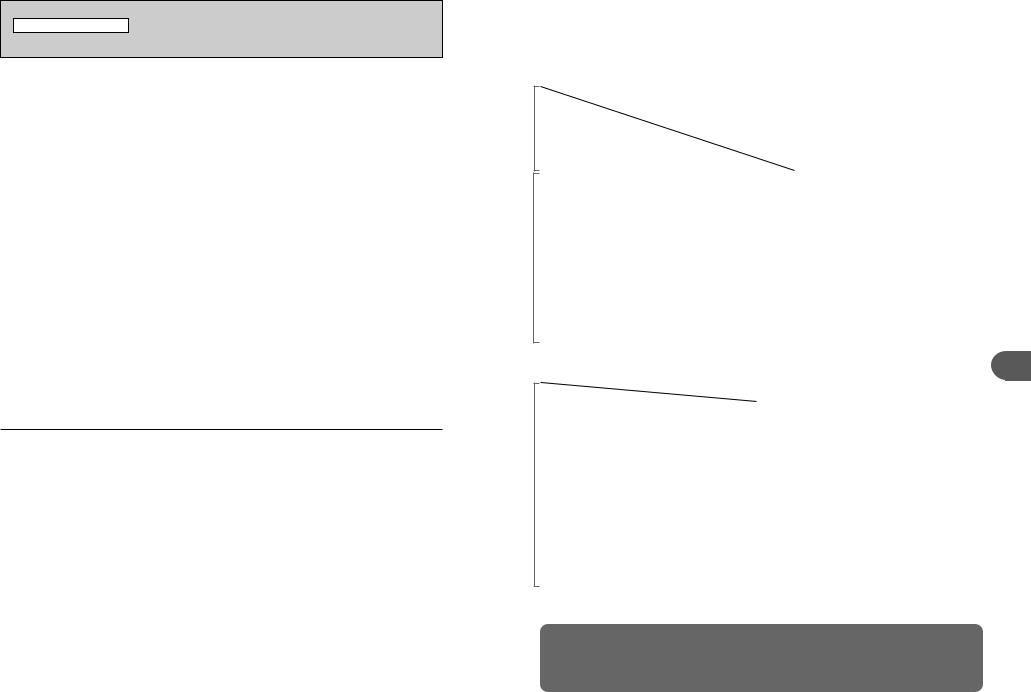
PHOTOGRAPHY FUNCTIONS
TAKING PICTURES — SELECTING THE CAMERA SETTINGS
Specify the camera settings for taking pictures to get the best result. A general guide is given below.
1 Select the Photography mode ( P.38-42). 
B |
Specifies all settings other than the “Quality”, “Sensitivity” |
|
and “FinePix COLOR” on the camera. |
√/À/U/,// |
Selects the best Scene position setting for the scene being |
|
shot. |
N/M/< |
Changes the aperture or shutter speed setting so that the |
|
action is frozen, the flow of the motion is conveyed, or the |
|
background is out of focus. |
> |
Adjusts all the camera settings yourself. |
2 Specify the photography settings ( P.43, 46-52). 
D Exposure compensation |
Uses the AE exposure as a reference value of 0. This |
|
function brightens (+) or darkens (–) the shot. |
e Macro |
Used for close-up shots. |
d Flash |
Used for shots in dark locations or for backlit subjects, etc. |
f Continuous shooting |
Used to take a series of continuous shots or to use auto |
|
bracketing (with exposure compensation). |
3 Take the pictures (check the exposure and focus adjust the shot composition press the shutter button down fully).
You can use the menus for more detailed settings ( P.54-65).
The table below provides a number of sample settings. Use the settings effectively.
To achieve this result |
Sample settings |
To express the motion of the subject |
Set the Mode dial to “M” and select a slow shutter speed. Use a |
|
tripod to prevent camera shake. |
To freeze the subject's movement |
Set the Mode dial to “M” and select a fast shutter speed. |
|
|
To make the subject stand out by having the background |
Set the Mode dial to “<” and select a wide aperture setting. |
out of focus |
|
|
|
To get a very large depth of focus |
Set the Mode dial to “<” and select a narrow aperture setting. |
|
Use a tripod to prevent camera shake because shutter speed |
|
decreases. |
|
|
To prevent the image from having a red or blue cast |
Change the “White balance” setting in the photography menu. |
due to the light source |
|
|
|
To prevent missing snapshot opportunities |
Take pictures in AUTO mode (see “Using the Camera”). |
|
Shoot with HIGH-SPEED SHOOTING. |
|
|
To prevent the subject from being overexposed or |
Use exposure compensation. |
underexposed and to show the substance and textures |
Select (+) if the background is pale and (–) if the background is |
of the subject clearly |
dark. |
|
|
|
|
|
|
|
|
|
|
|
|
|
|
|
|
|
|
|
■ List of functions available in each mode |
|
|
|
|
|
|
|
|
: YES , —: NO |
|||||||
|
|
|
|
|
|
|
|
|
|
|
|
|
|
|
|
|
|
|
|
|
Photography mode |
|
√ |
À |
U |
, |
/ |
|
|
|
|
||
|
|
|
|
|
|
B |
BLUR-ANTI |
LIGHT NATURAL |
PORTRAIT |
LANDSCAPE |
|
NIGHT |
N |
M |
< |
> |
|
|
|
|
|
|
|
|
|
|
|
|
|||||
Function |
|
|
|
|
|
|
|
P.38 |
|
|
|
|
P.39-42 |
|
||
D Exposure compensation |
|
P.43 |
— |
|
|
— |
|
|
|
|
|
|
— |
|||
Focus mode (S-AF/MF/C-AF) |
|
P.18 |
|
|
|
|
|
|
|
|
|
|
|
|||
|
|
|
|
|
|
|
|
|
|
|
|
|
|
|
|
|
e Macro |
|
|
|
|
P.46 |
|
|
|
|
— |
|
|
|
|
|
|
|
|
|
|
|
|
|
|
|
|
|
|
|
|
|
|
|
|
AUTO Auto flash |
|
P.48 |
|
|
— |
|
— |
|
— |
|
— |
— |
— |
||
|
|
|
|
|
|
|
|
|
|
|
|
|
|
|
|
|
|
b Red-eye reduction |
|
P.48 |
|
|
— |
|
— |
|
— |
|
|
|
|
||
d Flash |
d |
Forced flash |
|
P.48 |
|
|
— |
|
— |
|
— |
|
|
|
|
|
v Suppressed flash |
|
P.48 |
|
|
|
|
|
|
|
|
|
|
|
|||
|
|
|
||||||||||||||
|
|
|
|
|
|
|
|
|
|
|
|
|
|
|
|
|
|
c Slow synchro |
|
P.49 |
— |
— |
— |
|
— |
|
|
|
— |
|
— |
||
|
|
|
|
|
|
|
|
|
|
|
|
|
|
|
|
|
|
n Red-eye reduction + Slow synchro |
P.49 |
— |
— |
— |
|
— |
|
|
|
— |
|
— |
|||
|
f Top 3-frame |
|
P.51 |
|
|
|
|
|
|
|
|
|
|
|
||
f Continuous |
j Auto bracketing |
|
P.51 |
— |
|
|
— |
|
|
|
|
|
|
|
||
shooting |
k Final 3-frame |
|
P.51 |
|
|
|
|
|
|
|
|
|
|
|
||
|
|
|
|
|
|
|
|
|
|
|
|
|
|
|
|
|
|
h Long-period (up to 40 frames) |
P.52 |
|
|
|
|
|
|
|
— |
— |
— |
— |
|||
|
|
|
|
|
|
The flash cannot be used for Continuous shooting. |
||||||||||
■ List of menu options available in each mode |
|
|
|
|
|
|
|
|
: YES , —: NO |
|||||||
|
|
|
|
|
|
|
|
|
|
|
|
|
|
|
|
|
|
|
|
|
|
Factory |
B |
√/À/U/,// |
|
N |
M |
< |
> |
||||
|
|
|
|
|
Default |
|
||||||||||
FinePix photo |
˘ Quality |
P.54 |
÷ N |
|
|
|
|
|
|
|
|
|
|
|
||
|
|
|
|
|
|
|
|
|
|
|
|
|
|
|
||
û ISO |
P.56 |
— |
|
|
|
1 |
|
|
|
|
|
|
|
|||
mode |
|
|
|
|
|
|
|
|
|
|
|
|
|
|
|
|
ü FinePix COLOR |
P.57 |
STD |
|
|
|
|
|
|
|
|
|
|
|
|||
|
|
|
|
|
|
|||||||||||
|
Ä Self-timer |
P.60 |
OFF |
|
|
|
|
|
|
|
|
|
|
|
||
|
|
|
|
|
|
|
|
|
|
|
|
|
|
|
|
|
|
H |
|
) MULTI |
P.61 |
) |
— |
|
|
— |
|
|
|
|
|
|
|
|
|
|
|
|
|
|
|
|
|
|
|
|
|
|
||
|
|
_ SPOT |
P.61 |
— |
|
|
— |
|
|
|
|
|
|
|
||
|
Photometry |
|
|
MULTI |
|
|
|
|
|
|
|
|
|
|
|
|
|
+ AVERAGE |
P.61 |
— |
|
|
— |
|
|
|
|
|
|
|
|||
|
|
|
|
|
|
|
|
|
||||||||
Photography |
» White balance |
P.61 |
AUTO |
— |
|
|
— |
|
|
|
|
|
|
|
||
â High-speed shooting |
P.63 |
OFF |
|
|
|
|
|
|
|
|
|
|
|
|||
menu |
|
|
|
|
|
|||||||||||
|
|
|
|
|
|
|
|
|
|
|
|
|
|
|
|
|
|
|
|
|
|
|
|
|
|
|
|
|
|
|
|
|
|
|
|
|
|
|
Ï |
|
|
|
|
|
|
|
|
|
|
|
|
|
|
|
|
— |
|
|
— |
|
|
|
|
|
|
|
|
|
|
|
|
|
CENTER |
|
|
|
|
|
|
|
|
|
|
|
|
|
|
|
|
— |
|
|
— |
|
|
|
|
|
|
|
|
|
|
|
|
|
|
|
|
|
|
|
||||||
|
|
|
|
|
|
|
|
|
|
|
|
|
|
|
|
|
|
|
|
|
|
STD |
— |
|
|
— |
|
|
|
|
|
|
|
|
|
|
|
|
|
|
|
|
|
|
|
|
|
|
|
|
|
|
|
|
|
±1/3EV |
— |
|
|
— |
|
|
|
|
|
|
|
“À” Natural light can be selected in only the “AUTO” mode. Continuous AF (C-AF) cannot be used together.
When shutter speed and aperture adjustments alone do not give the correct exposure.
When the image is too bright |
When the image is too dark |
Lower the “û” sensitivity setting. |
Raise the “û” sensitivity setting. |
Use an ND filter (sold separately). |
Use flash. |
3
Features Advanced
36 |
37 |
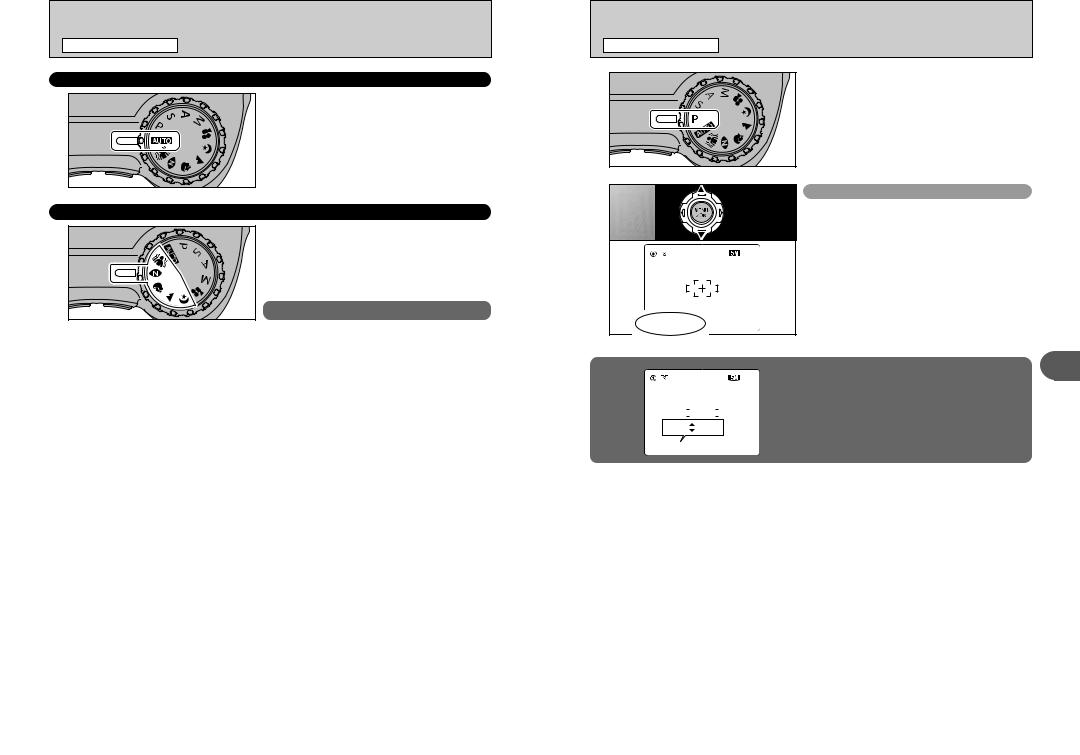
PHOTOGRAPHY FUNCTIONS SELECTING PHOTOGRAPHY MODE
B AUTO
SCENE POSITION
Set the Mode dial to “√”, “À”, “U”, “,” or “/” mode.
This mode provides the best Scene position setting for the scene being shot.
“U”, “,” and “/” cannot be selected Macro mode.
Scene position settings |
Explanation |
Available flash modes |
|
√Anti-blur |
Using this mode selects a fast shutter speed that reduces |
AUTO / b / d / v |
|
|
camera shake and moving-subject blurring. |
|
|
|
This mode produces beautiful images that retain the |
|
|
|
natural ambience when shots are taken in low-light |
|
|
|
conditions. This mode is also ideal for situations where the |
|
|
ÀNatural light |
flash cannot be used. |
Flash not available |
|
Sample uses: |
|||
|
|
||
|
• Portraits of sleeping children, pets and birthday cakes |
|
|
|
• Candlelit services (weddings, etc.) and school concerts |
|
|
|
• Restaurants, aquariums, museums and churches |
|
|
|
|
|
|
UPortrait |
Used for photography getting beautiful skin tones and soft |
AUTO / b / d / v / c / |
|
overall tone. |
n |
||
|
|||
|
|
|
|
,Landscape |
Used for shooting scenery in daylight and provides crisp, |
Flash not available |
|
|
clear shots of scenery such as buildings and mountains. |
|
|
|
Used for shooting evening and night scenes. This mode |
|
|
/Night |
allows you to take shots where priority is given to slow |
c / n / v |
|
shutter speeds of up to 3 seconds. To prevent camera |
|||
|
shake, always use a tripod. |
|
|
|
|
|
●! In Anti-blur or Natural light mode, when you have been used for long periods in places subject to extreme temperature rises, it will lower your image quality and streaking may also be visible in your images. If this occurs, turn the camera off several times to prevent heating the camera. Setting High-speed shooting mode to “OFF” is effective.
38
PHOTOGRAPHY FUNCTIONS |
NPROGRAMMED AUTO |
|
|
|
Set the Mode dial to “N”. |
|
|
This is an automatic mode to specify the settings |
|
|
except for the shutter speed and aperture setting. |
|
|
This is a simple way to take pictures the same as |
|
|
the Shutter-priority Auto and Aperture-priority Auto |
|
|
modes (Program shift). |
|
|
Program shift |
|
|
Press “a” or “b” to select different shutter speed |
|
|
and aperture setting combinations without changing |
|
|
the exposure setting. The shutter speed and |
|
N 12 |
in yellow when the camera |
|
. |
|
|
ISO 200 |
|
|
|
flash mode when using Program shift. |
|
|
Program shift: |
|
|
setting |
250 F3.2 |
|
Playback mode |
|
|
|
|
|
|
|
|
|
|
|
|
|
|
|
|
|
3 |
|
The shutter speed and aperture setting display |
||||||||||||||||
|
|
|
|
|
|
|
|
|
|
|
|
|
|
|
|
|
|
|
|
|
|
|
|
|
|
|
|
|
|
|
|
|
N 12 |
||
|
|
|
|
|
|
|
|
|
|
|
|
|
|
|
ISO 200 |
Advanced |
|
|
|
|
|
|
|
|
|
|
|
|
|
|
|
|
|
|
|
|
|
|
---- F--- |
||||||||||||||
|
|
|
Features |
||||||||||||||
|
|
|
|
|
|
|
|
|
|
|
|
|
|
|
|
|
|
|
|
|
---- F--- |
|
|
|
|
|
|
|
|
|
|||||
|
|
|
|
|
|
|
|
|
|
|
|
|
|
|
|
|
|
39
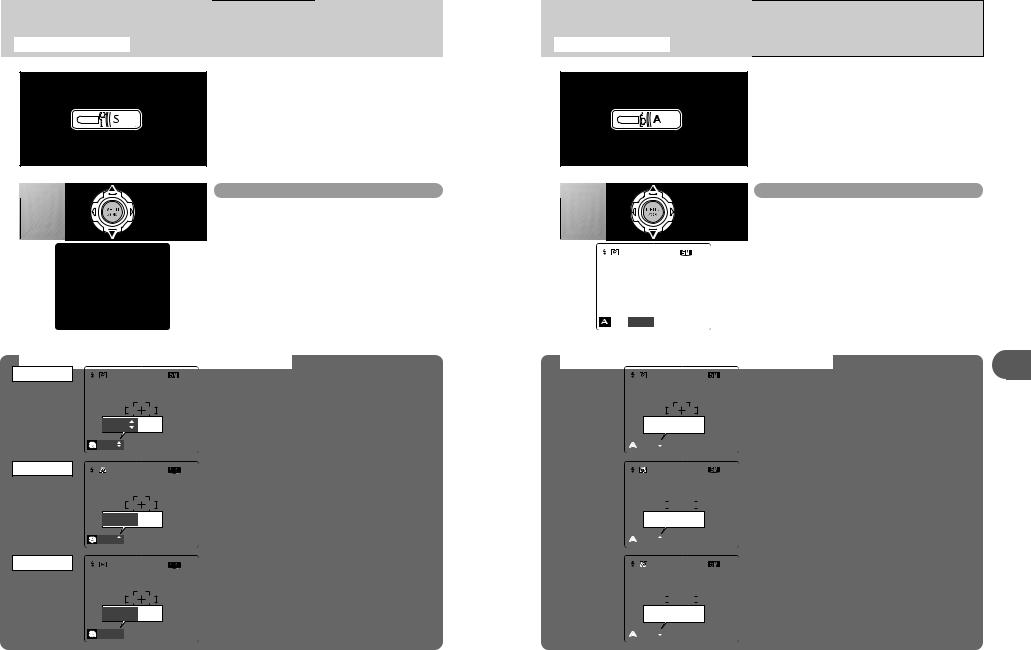
PHOTOGRAPHY FUNCTIONS MSHUTTER-PRIORITY AUTO
Set the Mode dial to “M”.
This is an automatic mode to set the shutter speed. Use this mode to freeze a moving subject (fast shutter speed) or convey the impression of movement (slow shutter speed).
Setting the shutter speed
|
|
Press “a” or “b” to select the shutter speed. |
|
|
|
hShutter speed setting |
|
|
|
3 sec. to 1/1000 sec. in 1/3 EV increments |
|
|
N 12 |
|
|
|
ISO 200 |
|
|
Shutter speed |
|
||
250 |
F3.2 |
|
|
The shutter speed and aperture setting display |
|||
Overexposed |
N 12 |
In scenes that are extremely overexposed, the |
|
aperture setting (F8) appears in red. When this |
|||
|
ISO 200 |
||
|
occurs, select a faster shutter speed (up to 1/1000 |
||
|
|
||
|
|
sec.). |
|
250 |
F8 |
250 F8 |
|
Underexposed |
N 12 |
|
ISO 200 |
In scenes that are extremely underexposed, the aperture setting (F3.2) appears in red. When this occurs, select a slower shutter speed (down to 3 sec.).
1000  F3.2
F3.2
1000 |
F3.2 |
|
Metering failed |
N |
12 |
|
ISO |
200 |
When the brightness of the subject is outside the camera’s brightness metering range, “F---” appears as the aperture setting. When this occurs, press the shutter button down halfway to measure the light level again and display a value.
250  F---
F---
250  F---
F---
PHOTOGRAPHY FUNCTIONS <APERTURE-PRIORITY AUTO
Set the Mode dial to “<”.
This is an automatic mode to set the aperture.
Use this mode to have the area in front of and behind the subject out of focus (large aperture) or have both near and far subjects in focus (small aperture).
Setting the aperture
Press “a” or “b” to select the aperture.
hAperture settings
F3.2 to F8 in 1/3 EV increments
 N 12
N 12
ISO 200
Aperture
250  F3.2
F3.2
The shutter speed and aperture setting display
Overexposed |
N |
12 |
In scenes that are extremely overexposed, the |
|
shutter speed setting (1/1000 sec.) appears in red. |
||||
|
ISO |
200 |
||
|
||||
|
|
When this occurs, select a larger number of aperture (up to F8).
|
|
|
|
|
|
|
|
|
|
|
|
|
|
|
|
1000 |
|
|
F3.2 |
|
|
|
|||||||||
|
|
|
|
1000 |
|
|
|
|
|
|
|
|
|
|
|
|
|
|
F3.2 |
|
|
|
|
|
|
In scenes that are extremely underexposed, the |
|||||
|
|
|
|
|
|
|
|
|
|
|
|
|
|
|
|
Underexposed |
|
|
|
|
|
|
|
|
|
|
|
N |
12 |
||
|
|
|
|
|
|
|
|
|
|
|
shutter speed setting appears in red. When this |
||||
|
|
|
|
|
|
|
|
|
|
|
|
|
ISO 200 |
||
|
|
|
|
|
|
|
|
|
|
|
|
|
|||
|
|
|
|
|
|
|
|
|
|
|
|
|
occurs, select a smaller number of aperture. |
||
|
|
|
|
|
|
|
|
|
|
|
|
|
|
|
|
|
|
|
|
|
|
|
|
|
|
|
|
|
|
|
|
|
|
|
|
|
|
|
|
|
|
|
|
|
|
|
|
|
|
|
|
|
4" |
|
|
|
|
|
|
|
|||
|
|
|
|
|
|
|
F |
8 |
|
|
|
|
|
||
|
|
|
|
|
|
|
|
|
|
|
|
|
|
|
|
|
|
|
4" |
F8 |
|
|
|
|
|
|
When the brightness of the subject is outside the |
||||
|
|
|
|
|
|
|
|
|
|
|
|
|
|
|
|
Metering failed |
|
|
|
|
|
|
|
|
|
|
|
N |
12 |
||
|
|
|
|
|
|
|
|
|
|
|
camera’s brightness metering range, “----” appears |
||||
|
|
|
|
|
|
|
|
|
|
|
|
|
ISO |
200 |
|
|
|
|
|
|
|
|
|
|
|
|
|
|
|||
|
|
|
|
|
|
|
|
|
|
|
|
|
as the shutter speed setting. When this occurs, press |
||
|
|
|
|
|
|
|
|
|
|
|
|
|
|
|
|
|
|
|
|
|
|
|
|
|
|
|
|
|
|
|
the shutter button down halfway to measure the light |
|
|
|
|
|
|
|
|
|
|
|
|
|
|
|
level again and display a value. |
---- |
|
|
|
|
|
|
|
|
|||||||
|
|
F3.2 |
|
|
|
||||||||||
|
|
|
|
---- |
|
|
|
|
|
|
|
|
|
|
|
|
|
F3.2 |
|
|
|
|
|
|
|
||||||
3
Features Advanced
40 |
41 |

PHOTOGRAPHY FUNCTIONS >MANUAL
 N 12
N 12
ISO 200
Shutter speed
250  F3.2
F3.2
01 
 02
02
 N 12
N 12
ISO 200
Aperture
250  F3.2
F3.2
Set the Mode dial to “>”.
Use Manual mode to set any shutter speed and aperture setting.
Setting the shutter speed
Press “a” or “b” to select the shutter speed.
hShutter speed setting
15 sec. to 1/2000 sec. in 1/3 EV increments
may appear on the
faster than 1/1000 sec., flash is used.
Setting the aperture
1Hold down the “D” button.
2Press “a” or “b” to select the aperture.
hAperture settings
F3.2 to F8 in 1/3 EV increments
The exposure indicator
screen as a guide
N 12
ISO 200
is outside the range, the exposure
Exposure indicator
250  F3.2
F3.2
PHOTOGRAPHY FUNCTIONS |
Available Photography modes: |
|
DEXPOSURE COMPENSATION |
||
N, M, < |
Use this function for shots to get the correct brightness (exposure), such as shots with extremely high contrast between the subject and the background.
1 |
Set the Power switch to “q”. |
|
2
3 10 |
02 |
 N 12
N 12
ISO 200
Exposure compensation indicator
 250
250 F3.2
F3.2
Set the Mode dial to “N”, “M” or “<” mode.
1Hold down “D” button.
2Press “d” or “c” to set the compensation value. The symbol indicating the compensation direction (– or +) turns yellow. The “D” icon also turns yellow while exposure compensation is being set and then turns blue after setting is completed.
hCompensation range
–2 EV to +2 EV (13 steps in 1/3 EV increments)
●! Exposure compensation cannot be used in the “B”, “√”, “À”, “U”, “,”, “/”, “>” and “r” modes.
●! The screen brightness will increase or decrease depending on the exposure compensation setting.
●! The following disables exposure compensation:
Shooting dark scenes in Forced flash “d” or Red-eye reduction mode “b”
This setting is retained when the mode is changed or the camera is turned off (D icon appears). Set the exposure compensation to “0” unless compensation is required.
To obtain the optimum brightness
Adjust the exposure compensation according to the level of brightness or darkness in the image.
hWhen the subject appears too bright |
hWhen the subject appears too dark |
Try a negative (–) compensation setting. |
Try a positive (+) compensation setting. |
This will make the overall image darker. |
This will make the overall image brighter. |
■ Guide to compensation
i Backlit portraits: +2 steps to +4 steps (+DWEV to +1DQEV)
i Very bright scenes (such as snowfields) and highly reflective subjects: +3 steps (+1 EV) i Shots made up predominantly of sky: +3 steps (+1 EV)
i Spotlit subjects, particularly against dark backgrounds: –2 steps (–DWEV)
i Scenes with low reflectivity, such as shots of pine trees or dark foliage: –2 steps (–DWEV)
3
Features Advanced
42 |
43 |
